Physical Address
304 North Cardinal St.
Dorchester Center, MA 02124
The classic patient with diabetic nephropathy (DN) typically presented with gradual progression of disease from microalbuminuria to proteinuria, usually about 15 years after onset of diabetes. Renal lesions are quite similar in type I and type II diabetes mellitus (DM), although the delay in clinical diagnosis of type II DM may give the appearance of shorter interval to DN in these patients. Patients with type I DM with DN have a high incidence of retinopathy, whereas only slightly more than half of those with type II DM and DN also have retinopathy. Type II DM and obesity are increasing epidemically worldwide, in adults and in children. Type II DM is particularly prevalent in some Native American Indian tribes, such as the Pima. DN only develops in about 30% of diabetic patients.
Recently a distinct subset of diabetic patients with chronic kidney disease (CKD) without significant proteinuria has been recognized. The term diabetic kidney disease (DKD) is now used to emphasize the varied clinical settings and manifestations of disease related to DM that can develop. Of note, moderately increased albuminuria (30–300 mg/day, albumin in urine, formerly called microalbuminuria ) in diabetic patients is not a stable fixed finding and more frequently regresses to normoalbuminuria rather than progressing to severely increased albuminuria (formerly called macroalbuminuria , >300 mg/day) or so-called overt proteinuria . The nonproteinuric progressive kidney disease patients have more associated cardiovascular disease than proteinuric DN patients. Although risk for progressive CKD is increased with albuminuria, even nonalbuminuric patients have excess risk for incident end-stage kidney disease, 7.8 times higher compared with their nondiabetic counterparts. The risk for significant, greater than 30% loss of glomerular filtration rate (GFR) was about 30% over 4-year follow-up in DKD patients with albuminuric DKD versus about 10% in the nonalbuminuric group. Risk factors for progression in the nonalbuminuric DKD patients included increased age, female sex, obesity, systolic blood pressure, poor glycemic control, and hypertriglyceridemia. There are limited biopsy studies of these patients with nonproteinuric DKD. Biopsies done for clinical cause in nonproteinuric diabetic patients with CKD were compared with classic proteinuric diabetic patients. There was absence of Kimmelstiel–Wilson nodules, and only mild mesangial expansion and glomerular basement membrane (GBM) thickening in the nonproteinuric diabetic patients compared with classic DN patients. In a small research protocol biopsy study of nonproteinuric versus proteinuric diabetic patients with decreased GFR, occasional typical diabetic glomerular changes were observed even in the nonproteinuric group, but they also demonstrated more prominent interstitial fibrosis and arteriosclerosis. Further assessment will be needed to assess the spectrum of lesions, their mechanisms, and the prognostic importance in this nonproteinuric subgroup of diabetic patients.
Patients with the typical course of DN usually do not undergo renal biopsy. Thus the biopsied diabetic patient is clinically atypical. Lesions other than DN, either alone or superimposed on DN, are thus common in this biopsied population, and their relative frequency in any given series depends on biopsy indications. DN also occurs in transplants, either as recurrent disease or as a de novo lesion. DN develops more rapidly in this population than in native kidneys, with DN lesions present on average 6 years after transplant.
The earliest changes in diabetic patients’ kidneys are renal enlargement, contributed to by both hyperfiltration and hypertrophy. By light microscopy, glomerular hypertrophy, hyperplasia, and thickened GBMs are present as early as 2 to 8 years after onset of diabetes in some patients (see schema in Fig. 4.1 ). Mesangial volume expansion can be detected even earlier by morphometry from electron microscopic (EM) examinations. Progressive increase in mesangial matrix and cellularity ensue and may culminate in diffuse increase in mesangial matrix or nodular glomerulosclerosis with associated hyaline in arterioles and occasionally in Bowman’s capsule (“capsular drop”; Figs. 4.2–4.5 ). The nodules, known as Kimmelstiel–Wilson nodules , have a lamellated appearance on silver stains ( Figs. 4.6 and 4.7 ). There often are dilated capillary aneurysms surrounding the expanded Kimmelstiel–Wilson nodules, resulting from mesangiolysis and loss of tethering of the capillary walls of the GBM to the mesangium ( Figs. 4.8–4.12 ). This repeated mesangiolysis with subsequent augmented mesangial matrix synthesis in a repair response gives rise to the laminated appearance. Occasionally, red blood cell fragments may be present in these nodules, consistent with more severe localized microvascular injury. Endothelial lumens within the nodules also may be present. Crescents can even be present, possibly resulting from rupture of such microaneurysms, although frank fibrinoid necrosis is not observed.
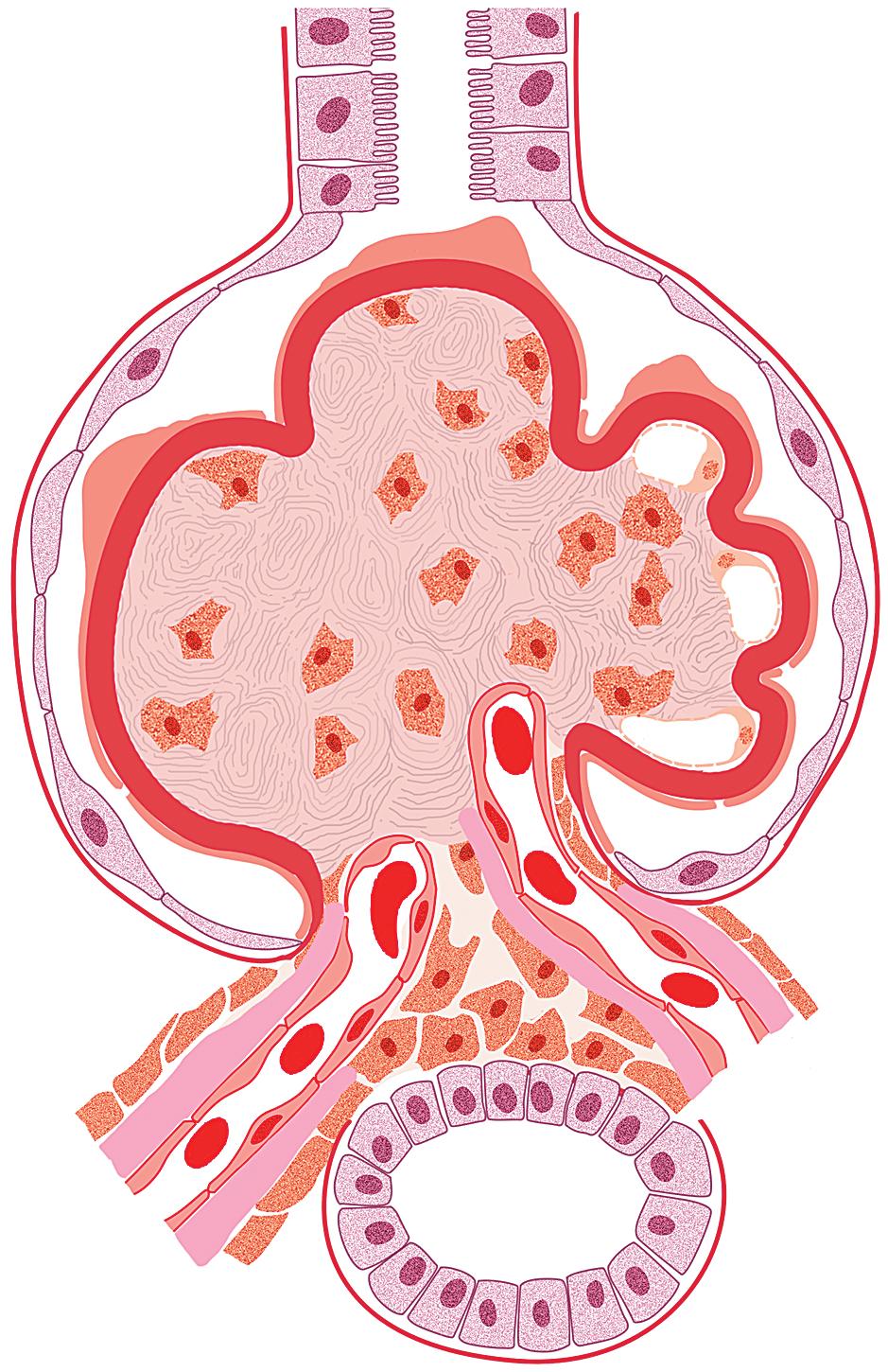
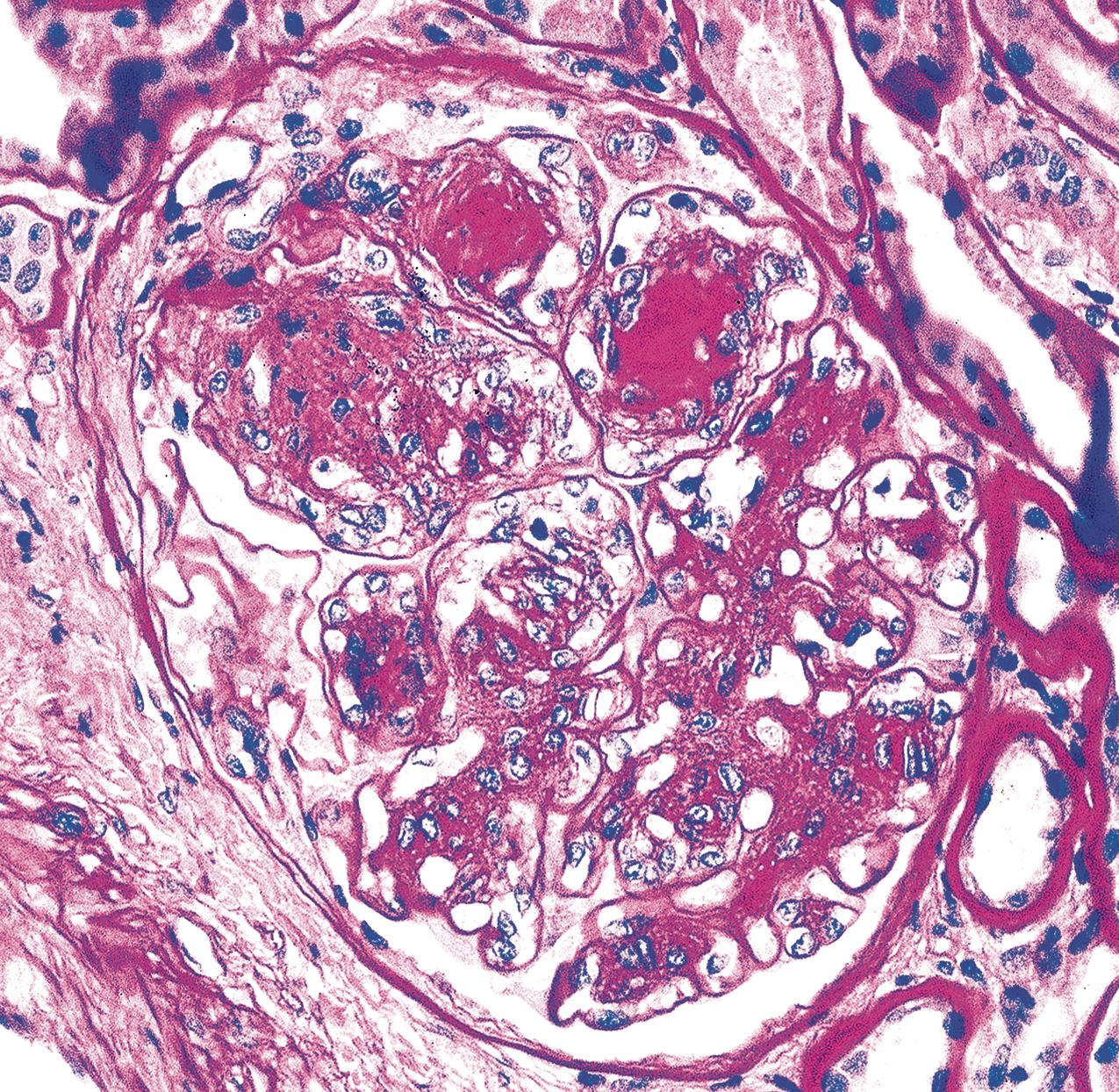
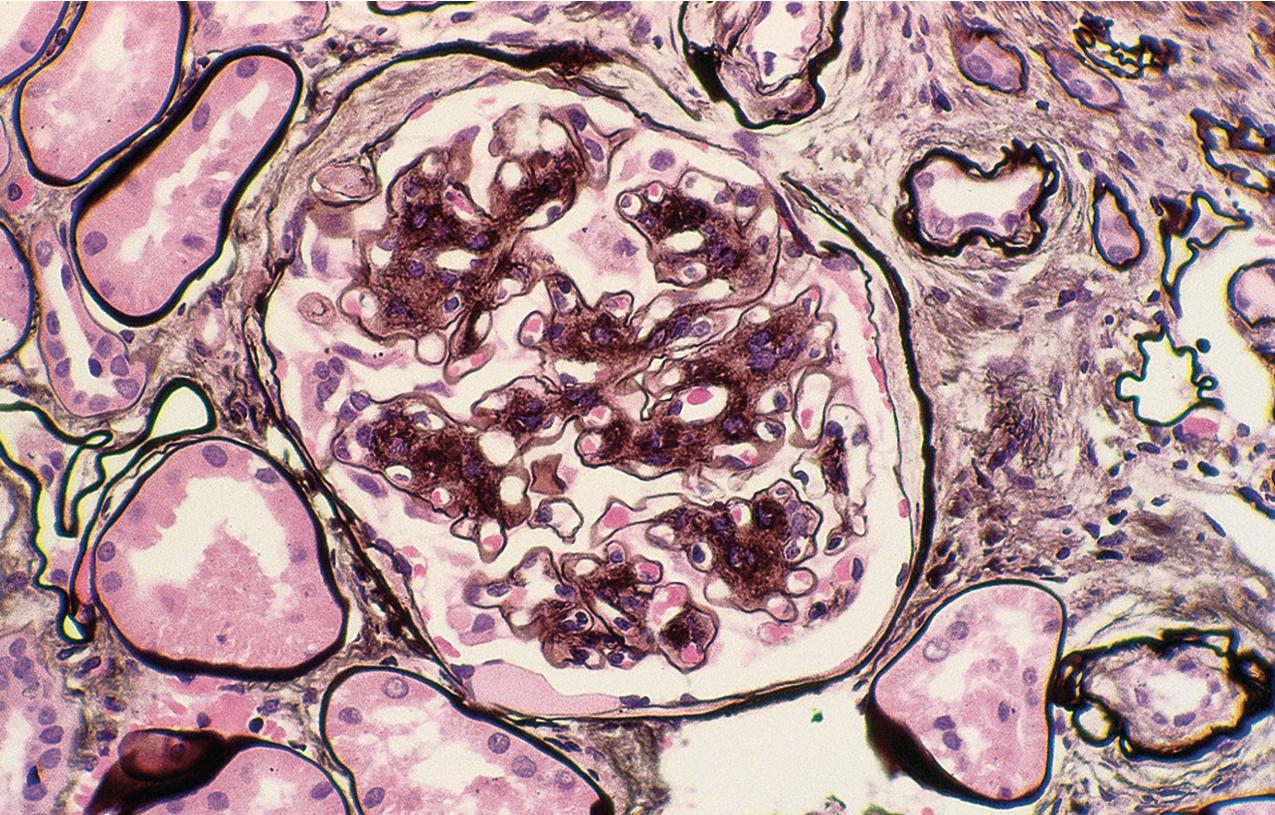
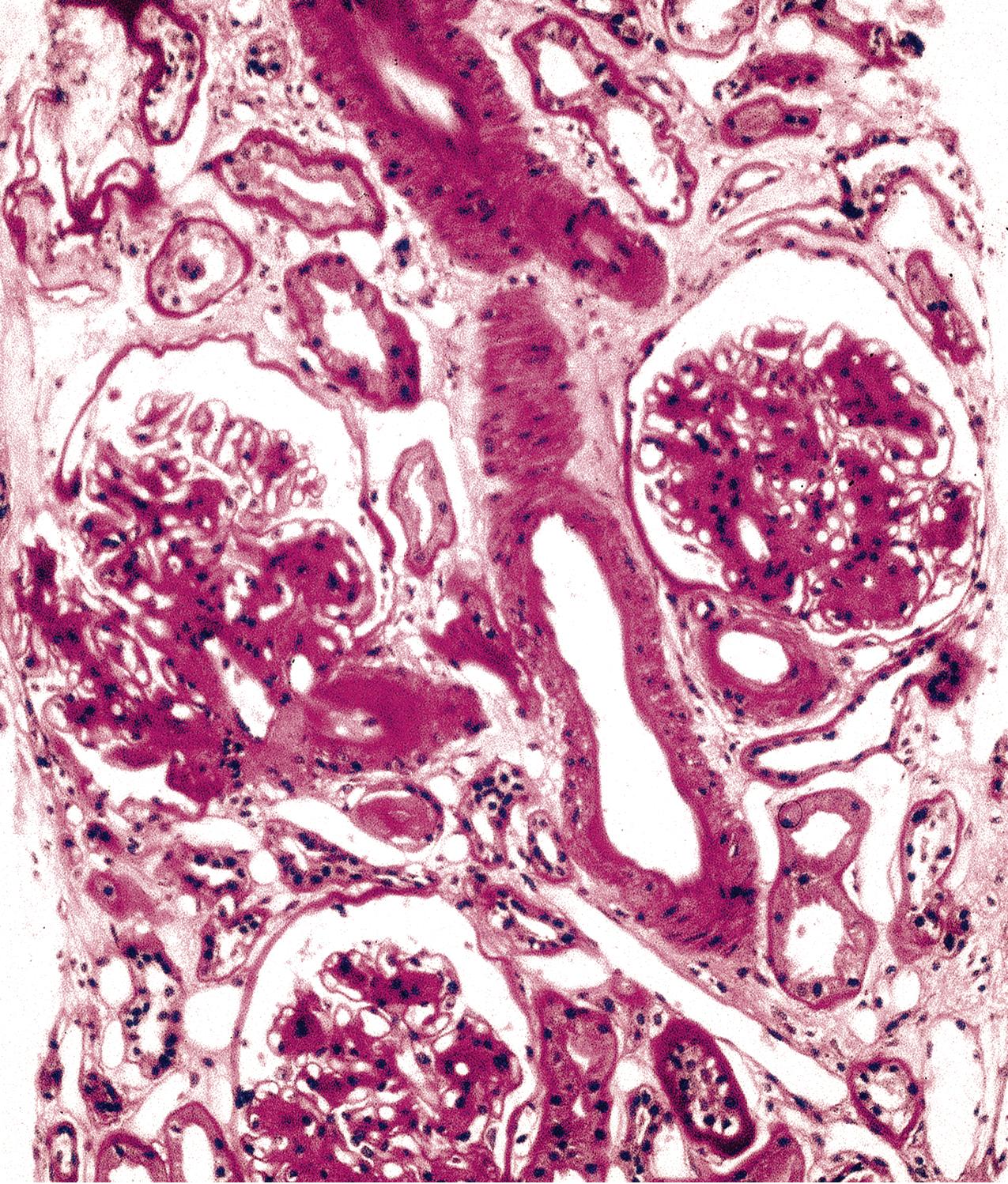
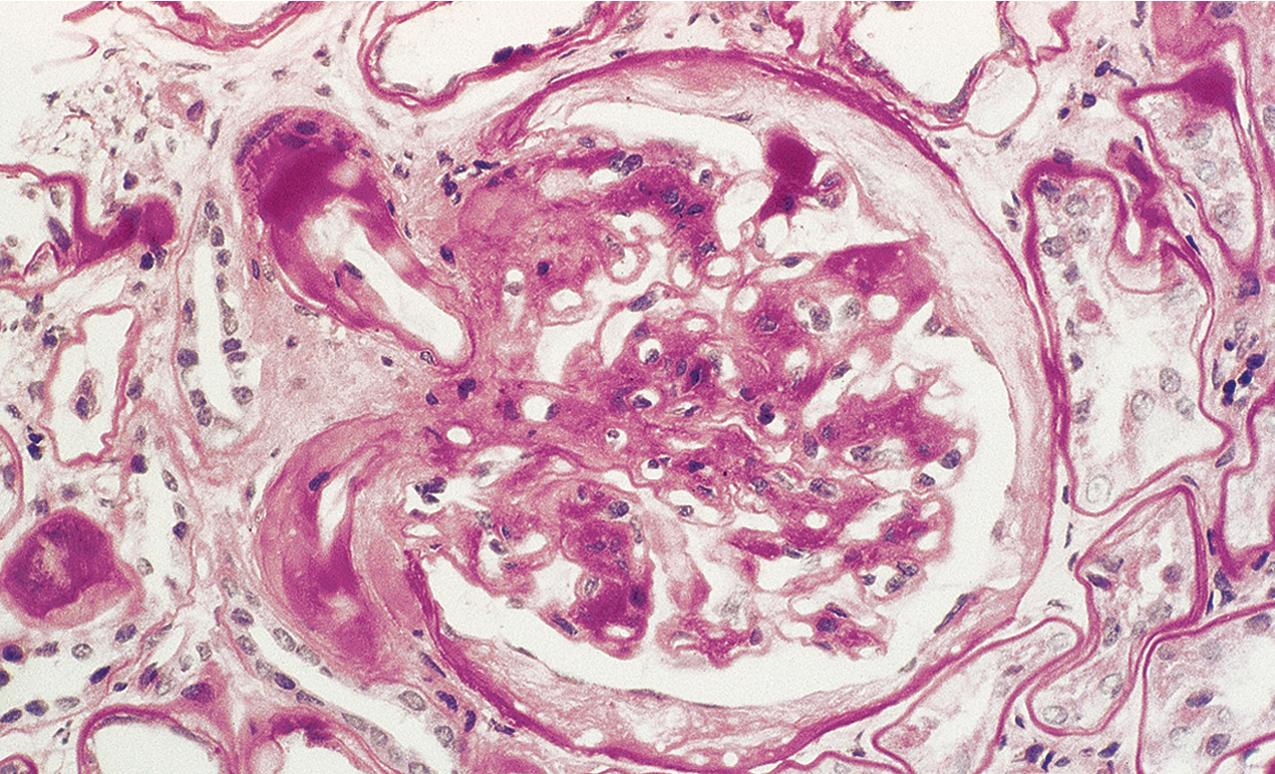
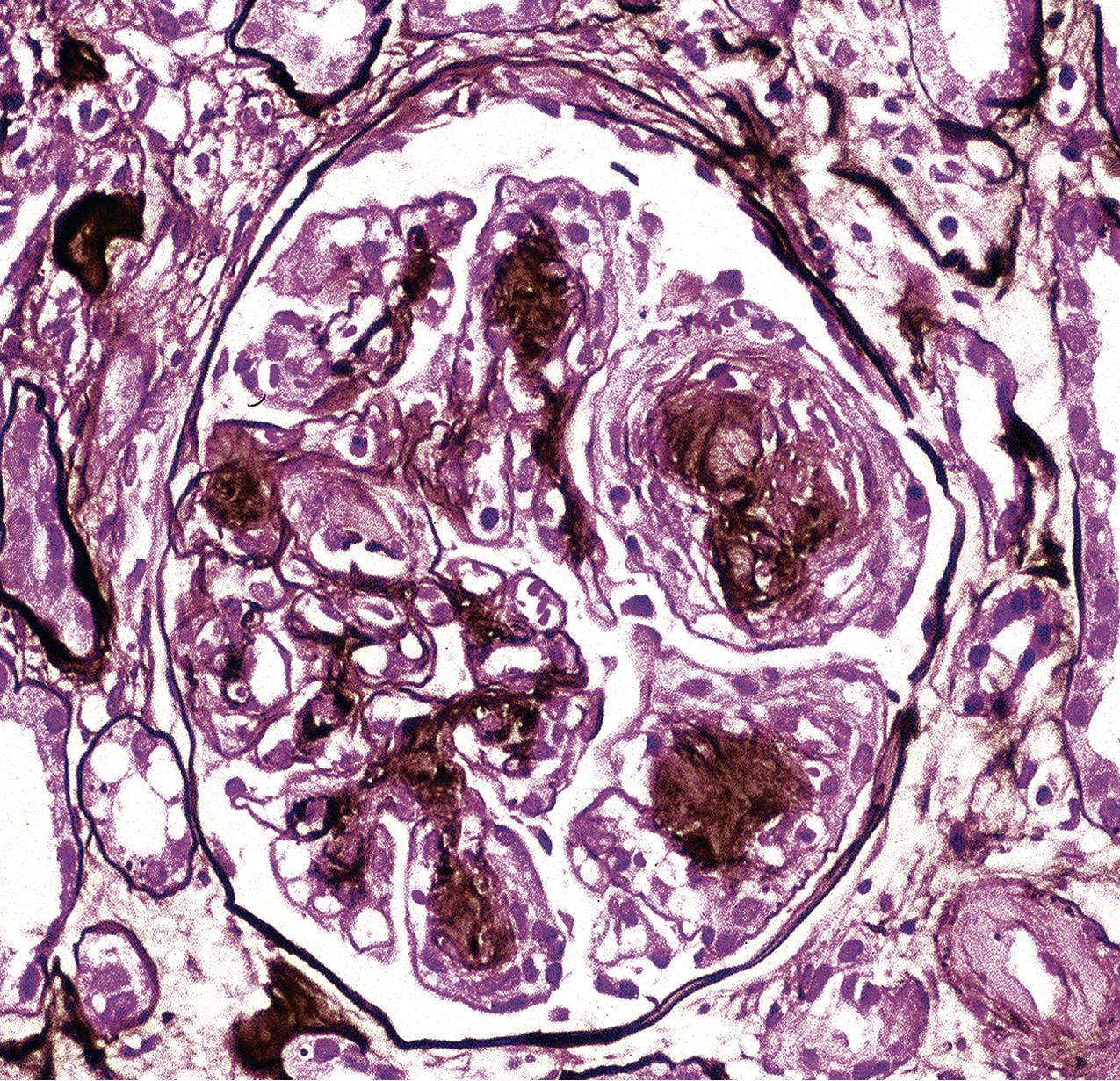
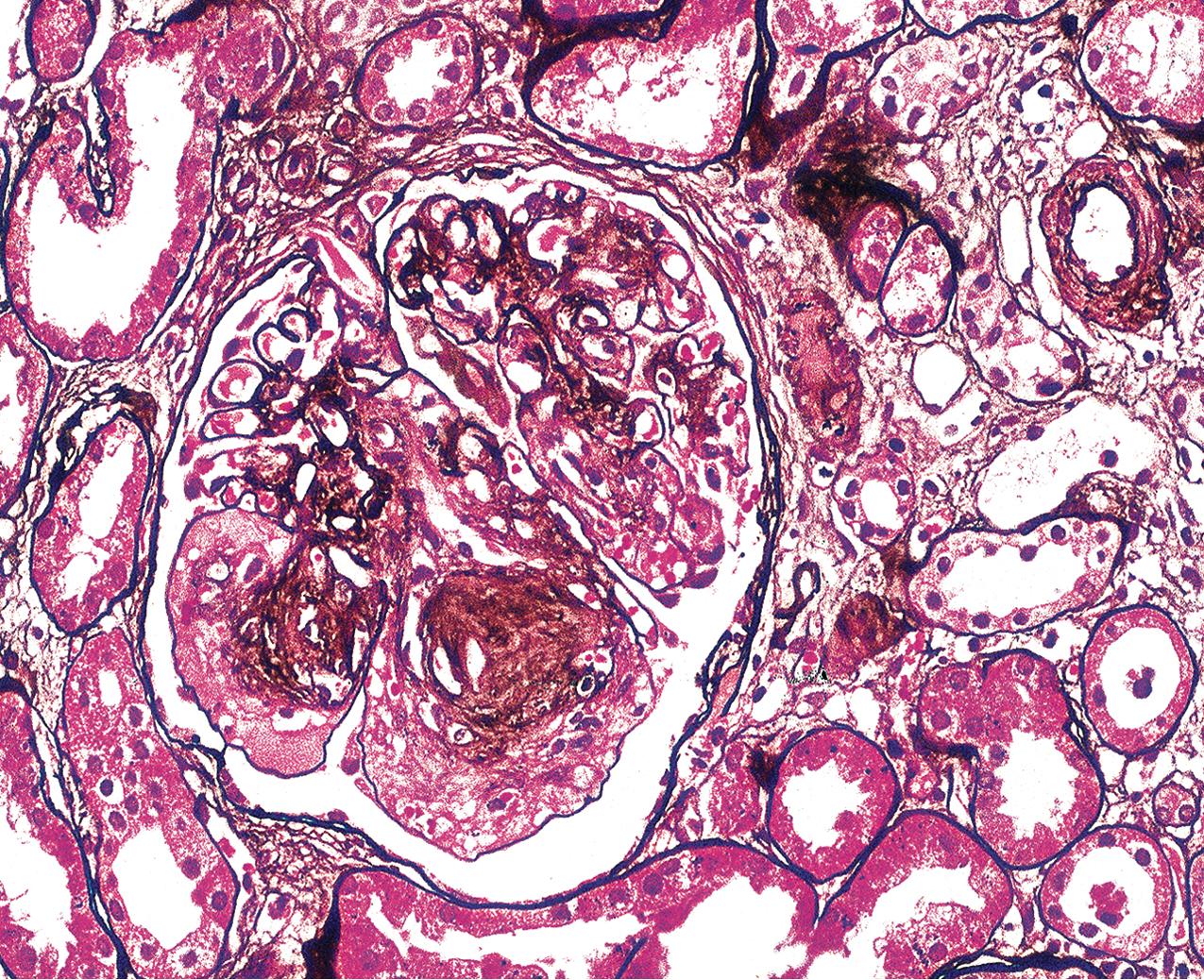
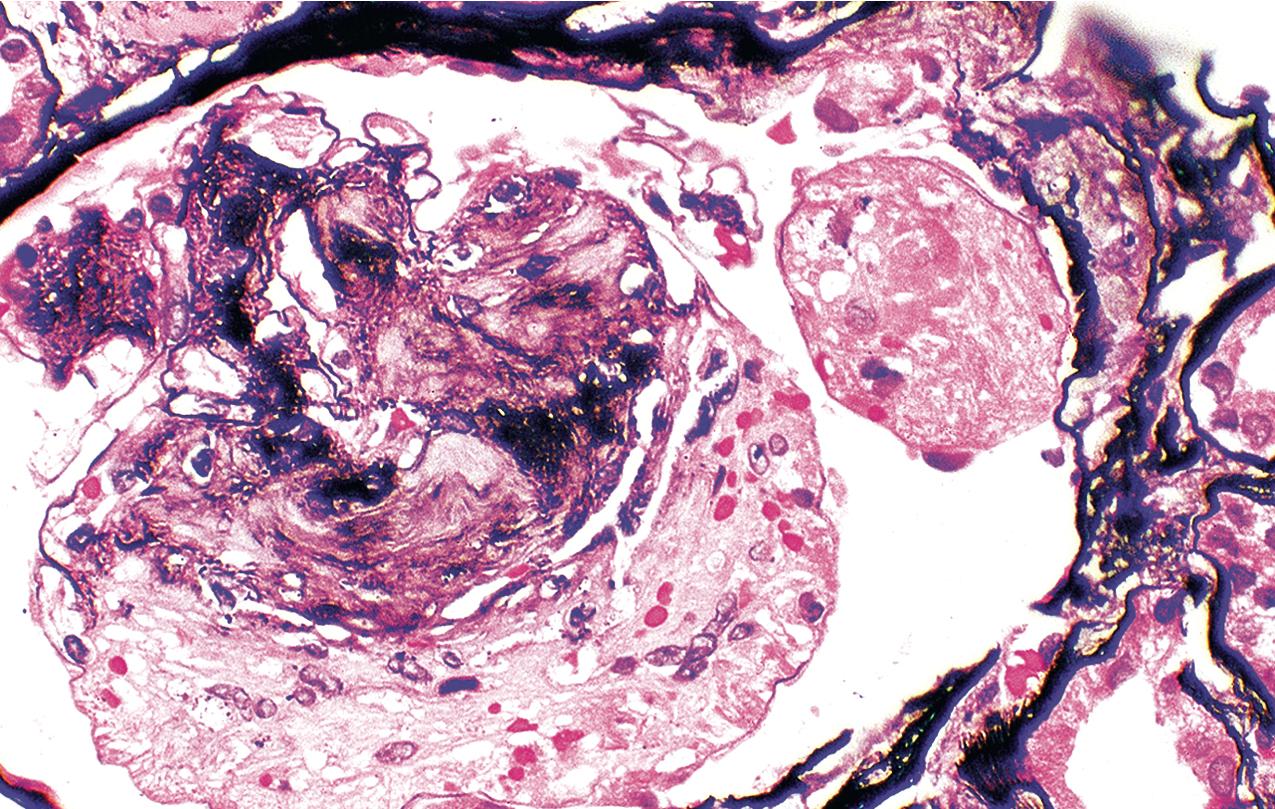
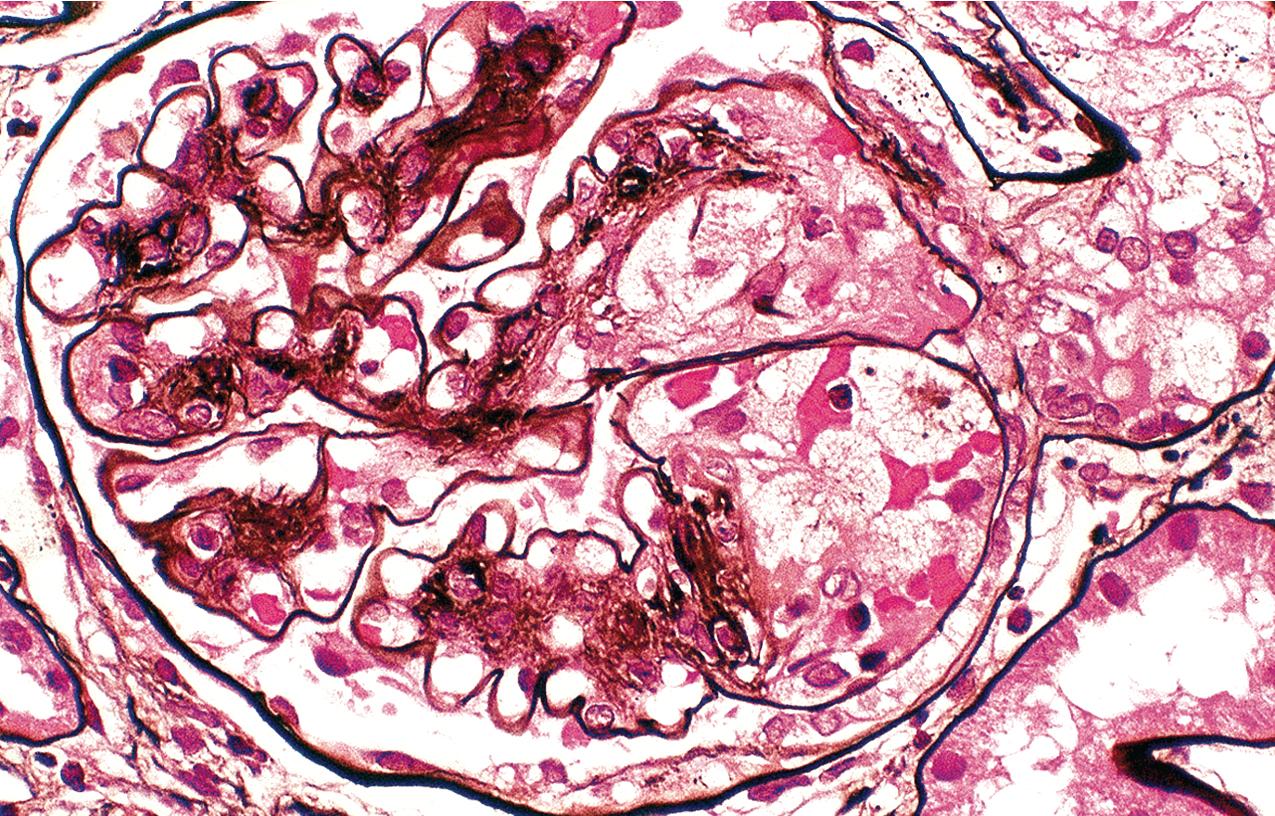
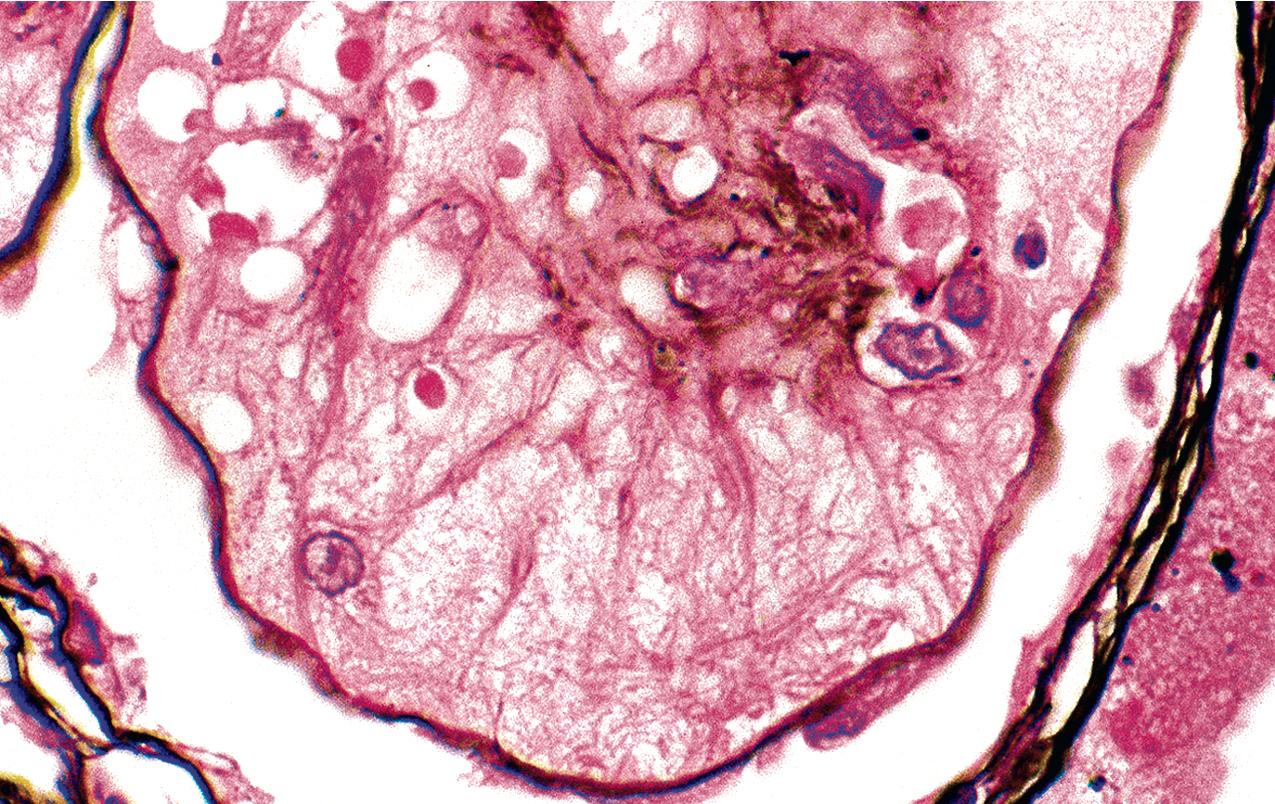
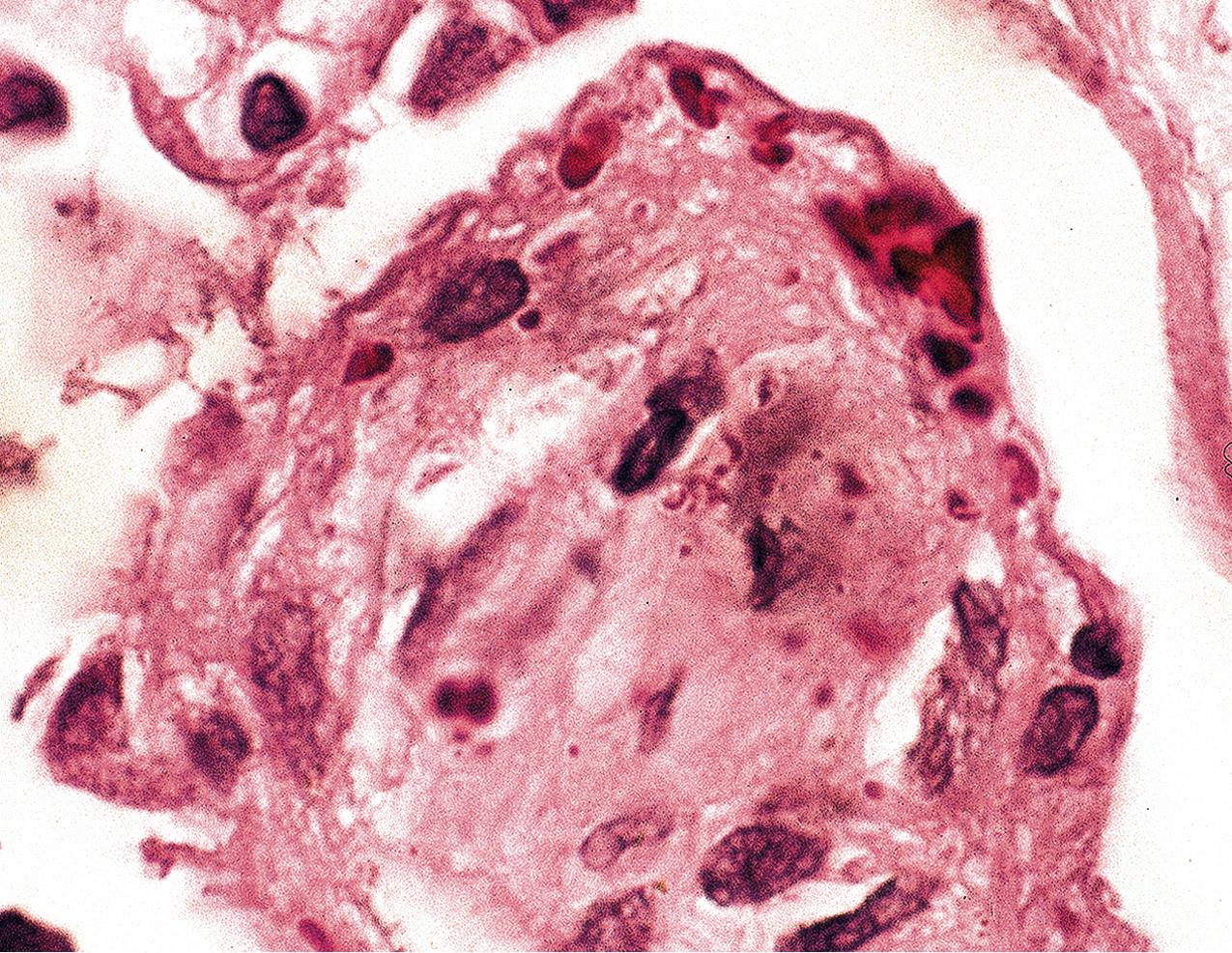
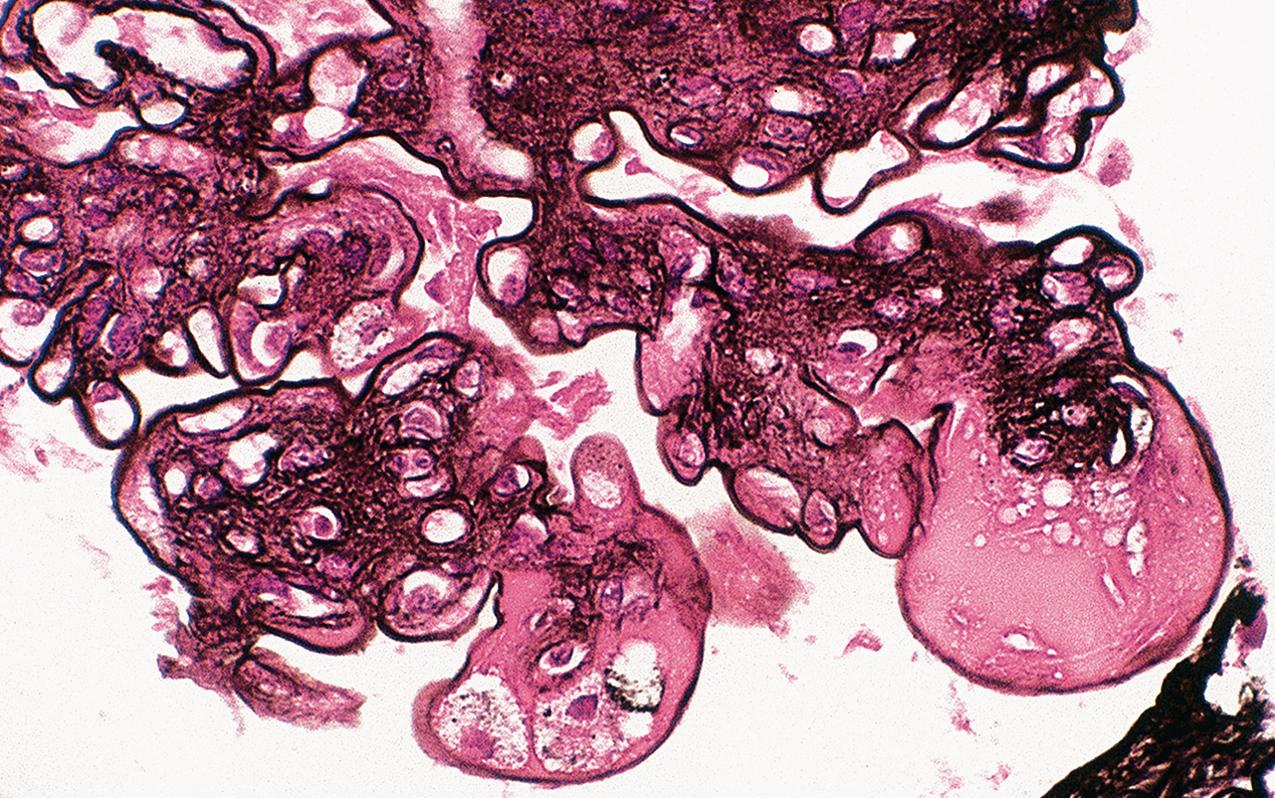
The GBM is diffusely thickened without spikes or double contours on silver stains. Hyalinosis is common in DN, resulting from insudation of plasma proteins. The term hyaline cap (also called fibrin cap ) is used to describe hyalinosis in peripheral segments of the glomerular tuft. The term capsular drop is used to describe the appearance of hyaline material within Bowman’s capsule. The latter lesion is quite rare, and highly specific, although not pathognomonic, for DN (see Fig. 4.13 ).
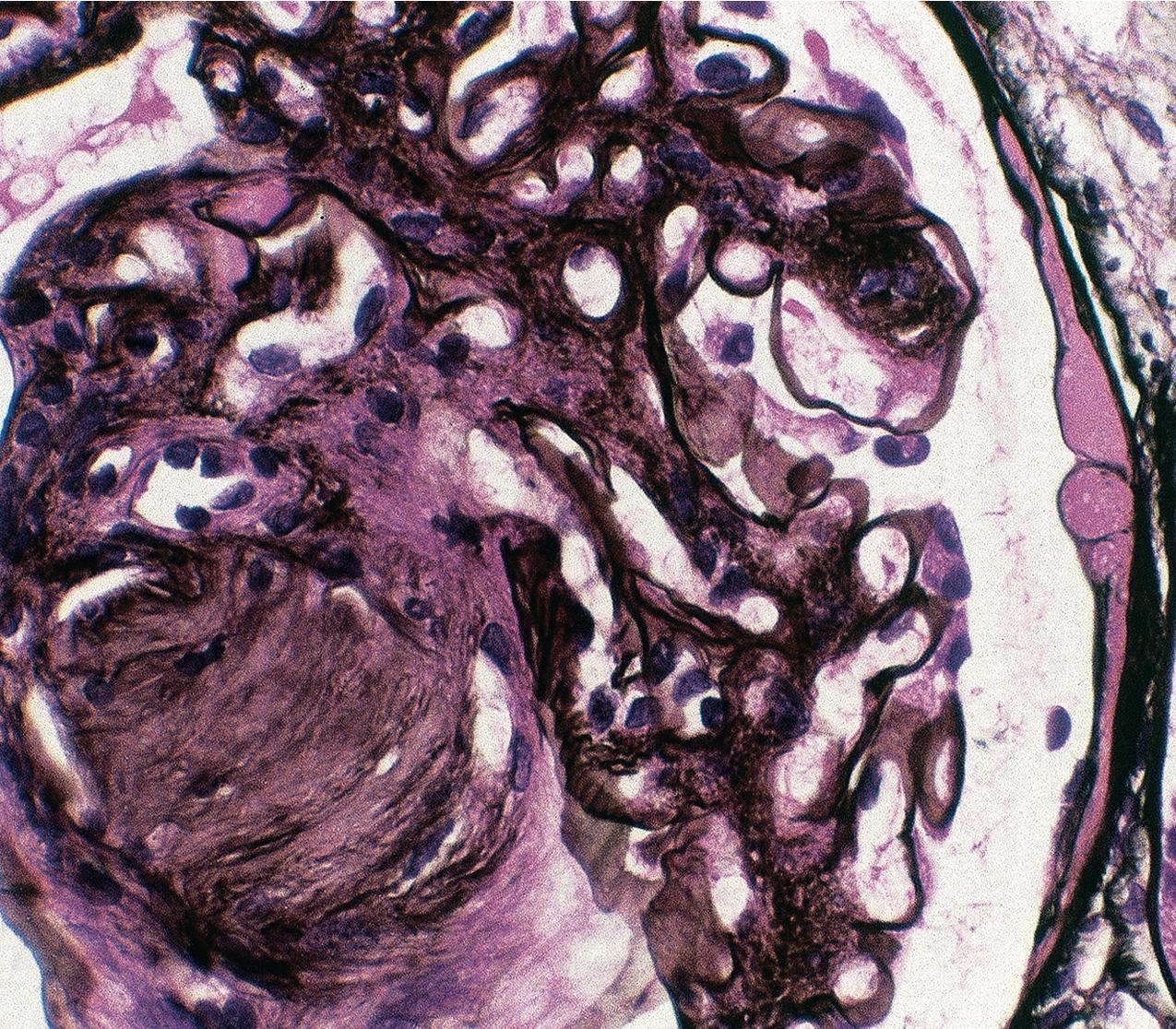
Overt DN is invariably accompanied by lesions of arterioles and arteries. Both afferent and efferent arterioles show hyalinosis in DN ( Fig. 4.3 ). In contrast, arterionephrosclerosis (ANS) affects the afferent, but not the efferent, arteriole. Interlobular and larger arteries typically show arteriosclerosis in DN.
There is proportional tubulointerstitial fibrosis in DN. An increase in the cellular component of the interstitium precedes an increase in matrix. Tubular basement membranes are thickened, and tubular atrophy and interstitial fibrosis occur in proportion to glomerulosclerosis (see Fig. 4.2 ).
By immunofluorescence microscopy, there may be linear accentuation of GBMs, typically strongest for immunoglobulin G (IgG; Fig. 4.14 ). Both kappa and lambda light chain usually stain, thus ruling out possible light chain deposition disease or light and heavy chain deposition disease, which have monoclonal light chain staining. Absence of accompanying significant GBM C3 staining or crescents, and the clinical history, also aid in differentiating this staining from anti-GBM antibody–mediated glomerulonephritis. Albumin, used as a control immunofluorescence (IF) stain, is also positive in these DN cases, showing the general “stickiness” of the altered GBM. There may also be linear accentuation with anti-IgG of Bowman’s capsule and tubular basement membranes.
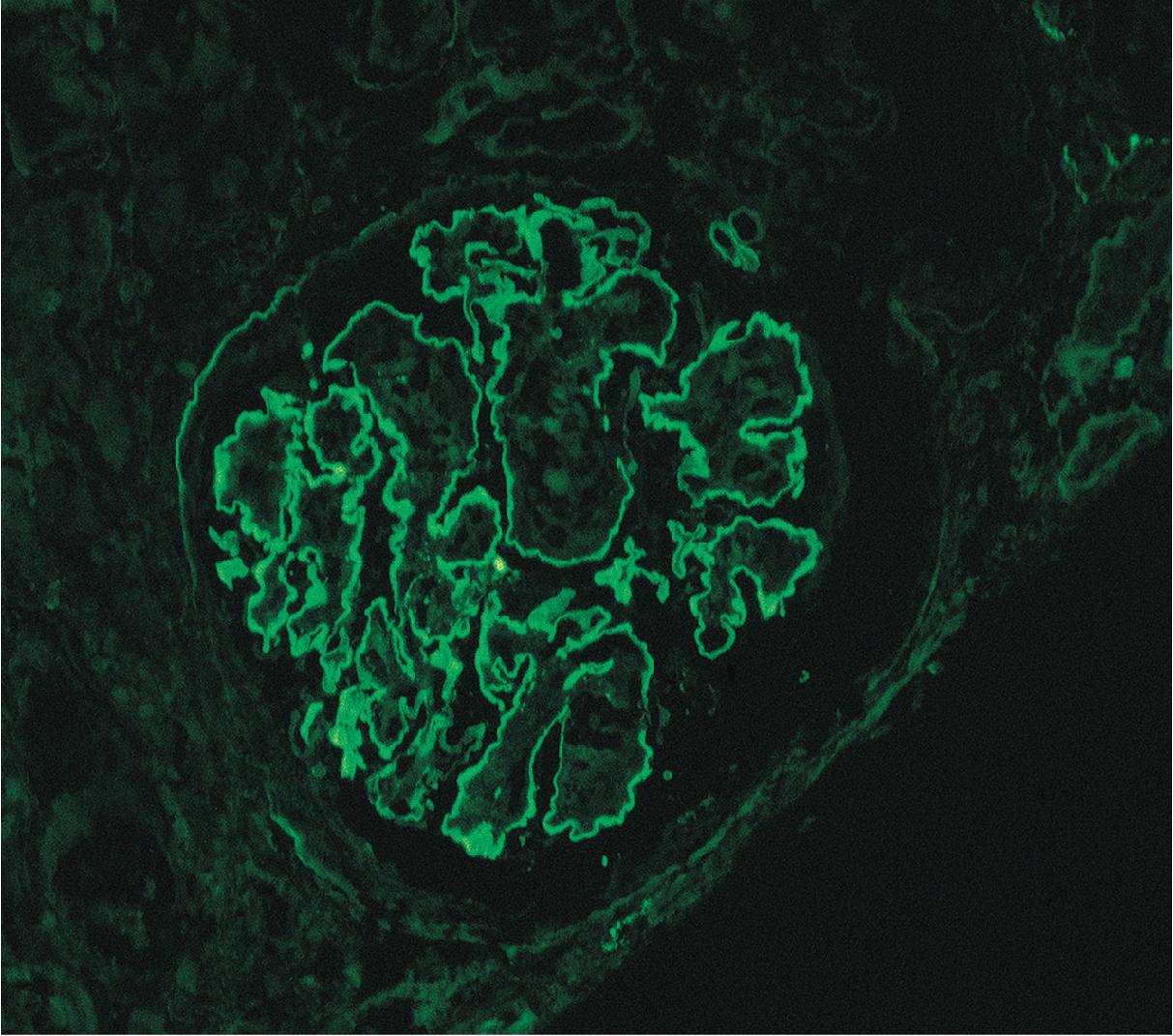
EM confirms the diffuse GBM thickening from widened lamina densa without immune complexes ( Figs. 4.15 and 4.16 ). The GBM may be several-fold normal thickness, up to 1200 to 1500 nm (normal in adult is around 325–375 nm). Podocytes show effacement of foot processes. The mesangial matrix is markedly expanded with lesser increase of mesangial cells, without immune complexes, with areas of neoangiogenesis within the expanding lamellated nodules. Areas of hyalinosis appear electron dense, are often present in sclerotic areas, often contain lipid, and should not be confused with immune complex–type deposits. Mesangiolysis is also evident by EM, with red blood cell (RBC) fragments, loss of matrix, and even fibrin tactoids in areas of active disruption of the mesangium ( Fig. 4.17 ). Correlation with IF and light microscopic findings is helpful in this regard. Superimposed, nondiabetic lesions are not uncommon, and complete examination by IF and EM should be done to investigate this possibility ( Fig. 4.18 ). A recent schema to classify different levels of severity of this spectrum of morphologic alterations has been developed. This schema is not intended for diagnosis but rather as a research tool for comparisons of progression and response to interventions in research settings ( Table 4.1 ). Recent studies have indeed shown that these stages of glomerular lesions and interstitial fibrosis/tubular atrophy were correlated with clinical outcome, with worse renal survival associated with worse stage on biopsy.
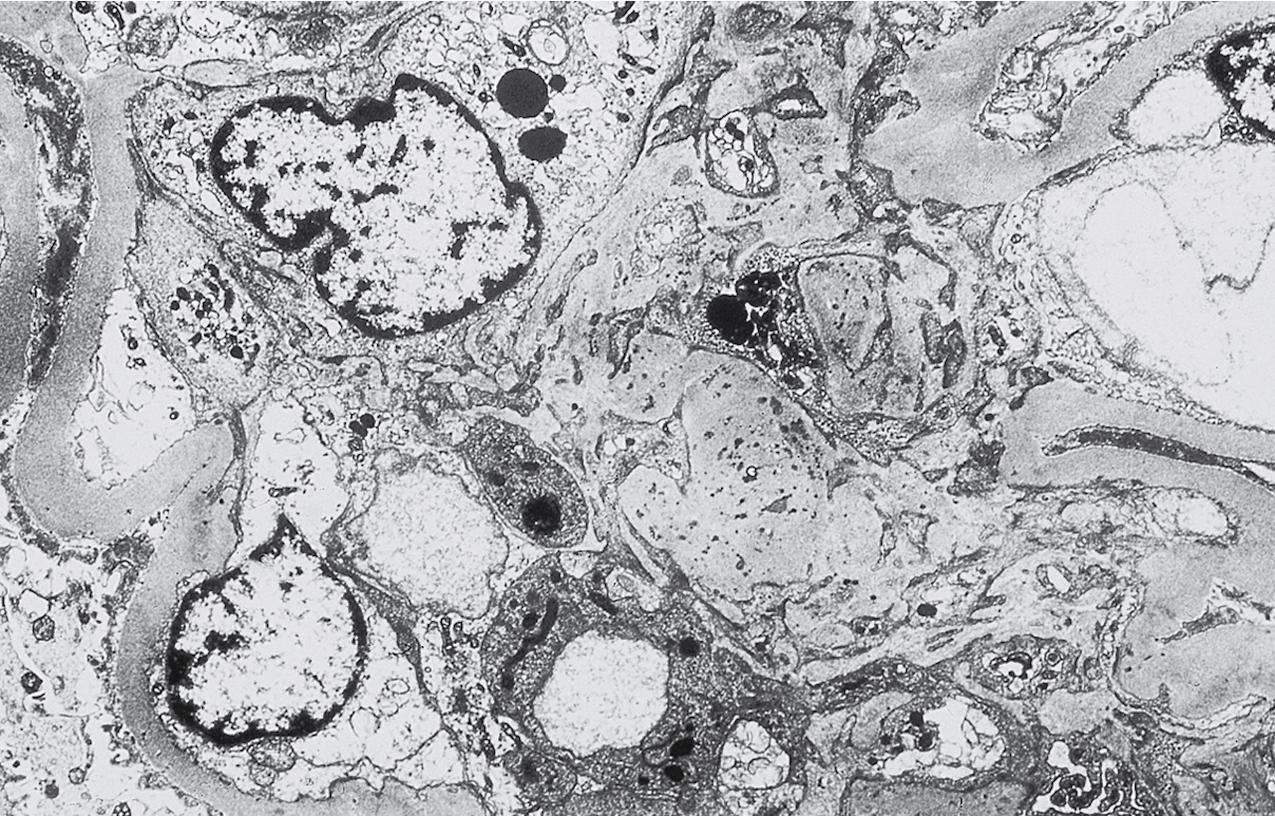
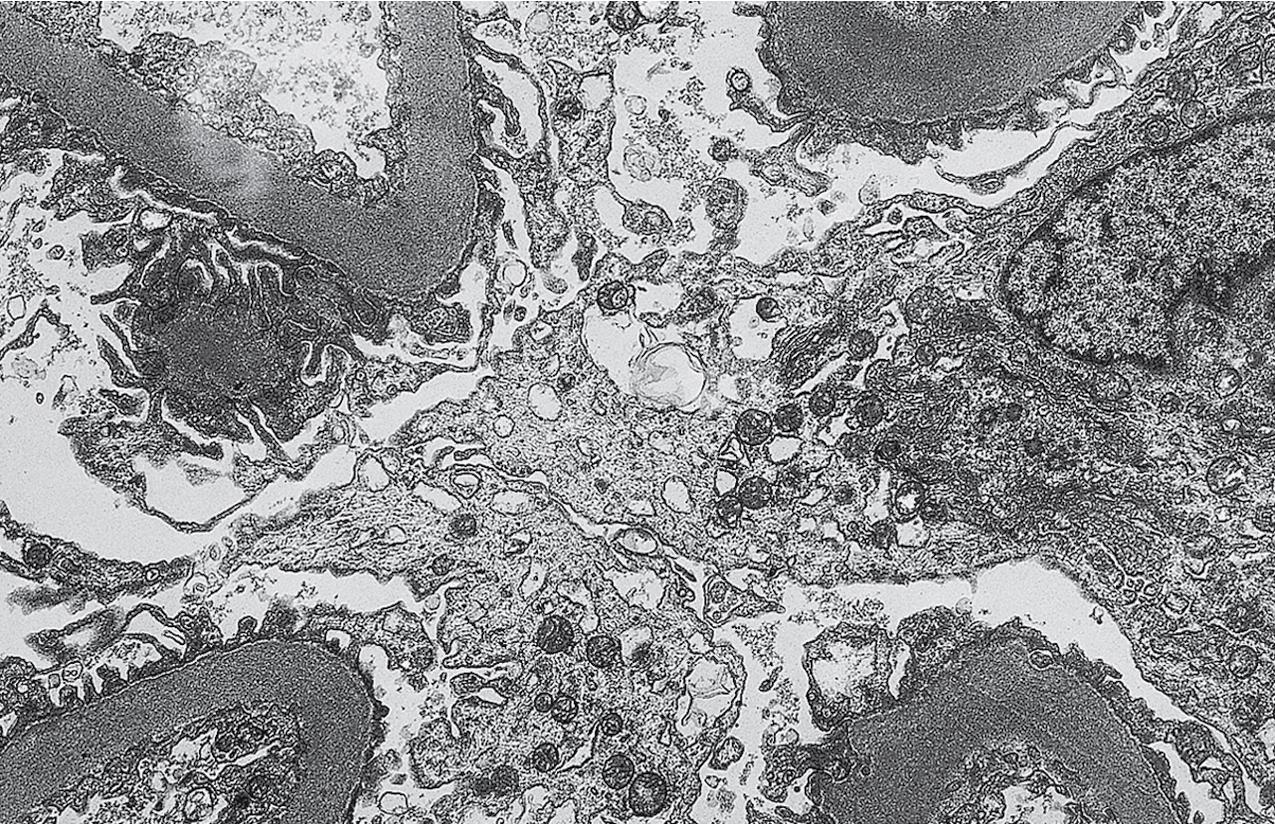
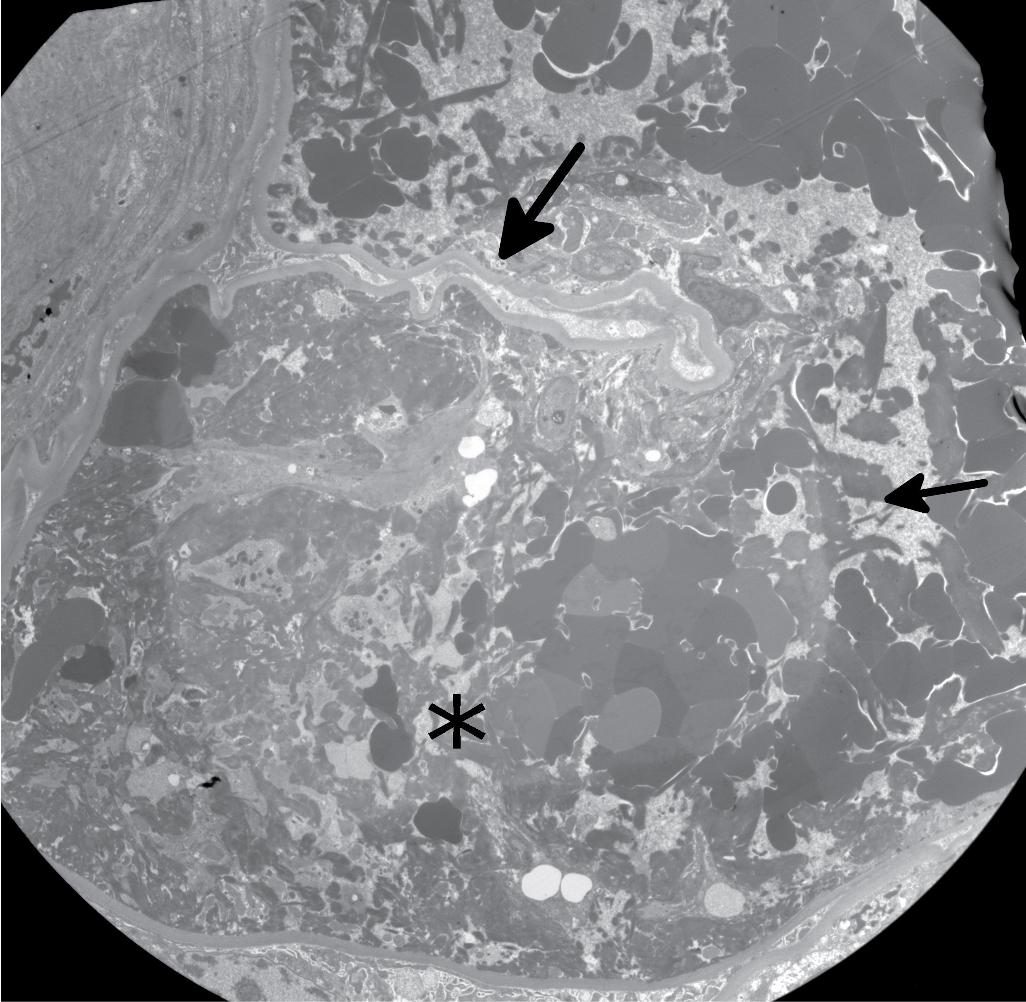
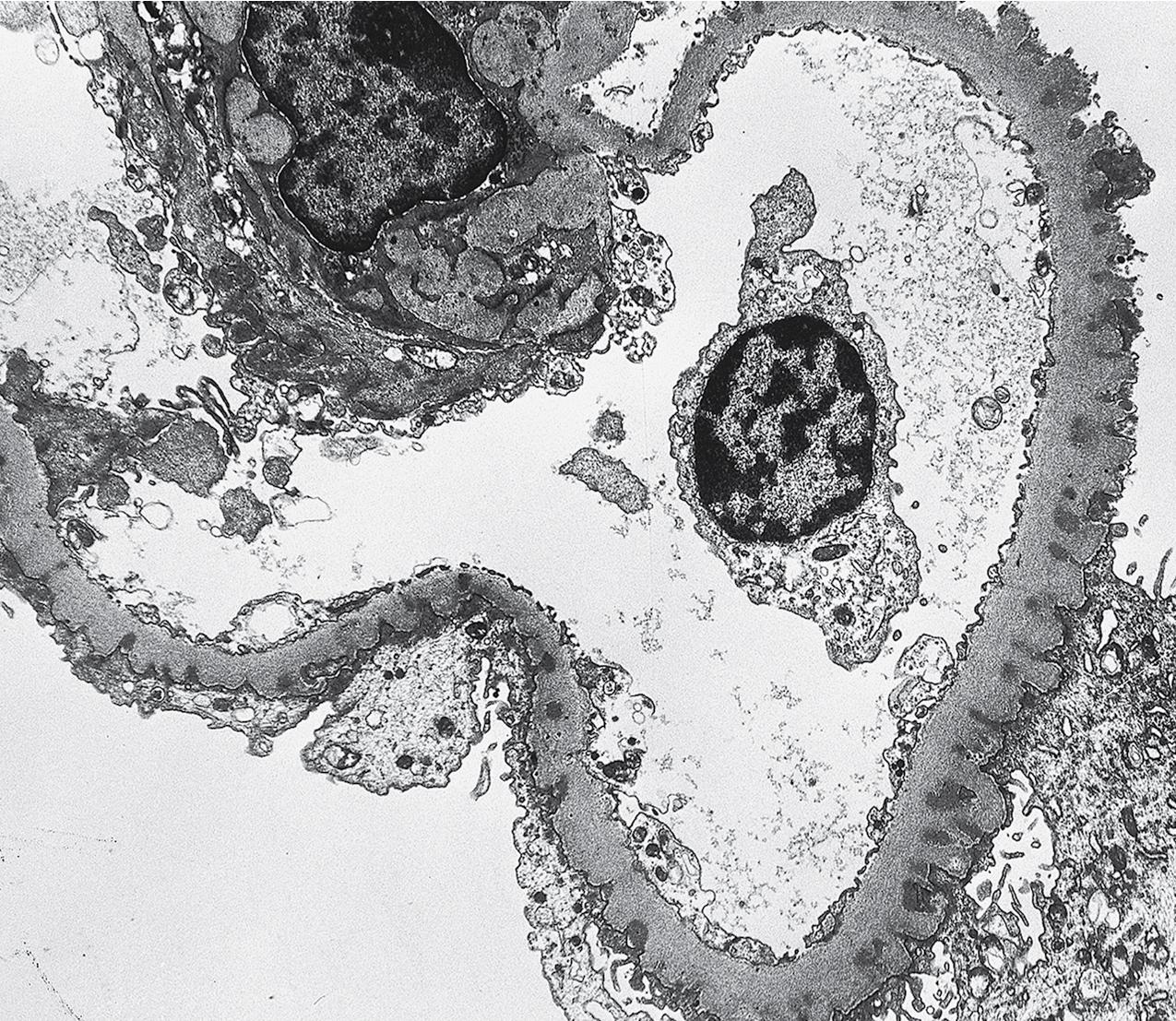
| Class | Description | Inclusion Criteria |
|---|---|---|
| I | Mild or nonspecific LM changes and EM-proven GBM thickening | Biopsy does not meet any of the criteria mentioned for class II, III, or IV |
| GBM >395 nm in female and >430 nm in male individuals 9 years of age and older | ||
| IIa | Mild mesangial expansion | Biopsy does not meet criteria for class III or IV |
| Mild mesangial expansion in >25% of the observed mesangium | ||
| IIb | Severe mesangial expansion | Biopsy does not meet criteria for class III or IV |
| Severe mesangial expansion in >25% of the observed mesangium | ||
| III | Nodular sclerosis (Kimmelstiel–Wilson lesion) | Biopsy does not meet criteria for class IV |
| IV | Advanced diabetic glomerulosclerosis | At least one convincing Kimmelstiel–Wilson lesion |
| Global glomerular sclerosis in >50% of glomeruli | ||
| Lesions from classes I through III may coexist |
Because biopsied diabetic patients are not typical, lesions other than DN may frequently be encountered. On the other hand, the renal biopsy may show lesions of DN preceding clinical diagnosis of overt type II DM. Differential diagnosis is listed in the box titled “Key Differential Diagnosis of Diabetic Nephropathy.” Of note, obesity-related glomerulopathy is characterized by marked glomerulomegaly, occasionally with hilar-type focal segmental glomerulosclerosis (FSGS). GBM thickening may be present, but it is not usually as prominent as in DN, and sclerosis is not usually nodular. Although vascular lesions may be present, related to hypertension, only the afferent arteriole demonstrates hyalinosis.
Idiopathic nodular sclerosis is diagnosed by exclusion of other causes and may have morphologic appearance and matrix content indistinguishable from DN. This morphologic lesion is loosely associated with smoking history and is seen typically but not exclusively in older white men.
Diabetic nephropathy occurs in only 30% to 40% of patients with DM. Some patients develop classic morphologic lesions of DKD without evident clinical manifestations, as shown by an interesting autopsy study of diabetic patients. Further, not all patients with DM who receive a kidney transplant develop recurrent DN in the transplant. Thus multiple complex factors are involved with the pathogenesis of DN.
In patients with type II DM who are carefully screened by clinical criteria to have DKD as a cause of their proteinuria, renal biopsy done for clinical research studies indeed demonstrated lesions of classic DN similar to those in type I DM. In one series of unscreened patients with type II DM biopsied for proteinuria, varying renal lesions, including various immune complex and other diseases, were present in one-third of patients. As previously stated, importantly, typical diabetic patients are not usually biopsied. Therefore the finding of lesions other than or superimposed on DN is common in clinically indicated renal biopsies in diabetic patients, and such findings will depend on the criteria used for biopsy.
Regression of mild DN lesions occurred in nondiabetic patients who inadvertently received kidney transplants with early DN lesions. In studies of patients who had their type I DM cured by pancreas transplant, regression of existing mild to moderate DN lesions was proven by repeat biopsies over a 10-year period. These important observations show the potential for modifying the course of DN. Possible factors involved with development of diabetic nephropathy include, but are not limited to, abnormal intraglomerular hemodynamics and permselectivity defects, the renin–angiotensin system, advanced glycation end products, growth factors such as transforming growth factor beta, the plasmin/plasminogen activator system and matrix turnover, insulin/glucose and related metabolites, oxidative stress, mitochondrial injury, deranged autophagy, podocyte loss, endothelial and mesangial injury, increased vascular endothelial-derived factor (VEGF) with excess angiogenesis early and loss of VEGF late, and infiltrating inflammatory cells.
The etiology of injury in nonproteinuric diabetic patients with CKD is not determined. The phenotype is not fully explained by blunting of proteinuria because of widespread use of angiotensin-converting enzyme inhibitors (ACEIs) and angiotensin type 1 receptor blockers (ARBs). Postulated mechanisms in these patients include ischemia, with subtly unrecognized acute kidney injury, and/or cardiovascular disease and/or increased inflammation. The remarkable additional protection against progressive CKD and cardiovascular complications seen with sodium glucose cotransporter 2 (SGLT2) inhibitors in DM patients is of interest and not explained by the modest decrease in hyperglycemia by inhibiting uptake of filtered glucose by the tubule. Beneficial effects were most pronounced in those diabetic patients with most proteinuria, and minimal in nonalbuminuric DM patients in one study. Nevertheless, recent data showed benefit even in nondiabetic proteinuric CKD patients. Additional hemodynamic effects, decreased mitochondrial stress, decreased reactive oxygen species, and other mechanisms have been postulated. Further unraveling of mechanisms of the unexpected magnitude of benefit will aid in understanding the spectrum of derangements that contribute to progressive DKD and progressive CKD in general.
Mesangial expansion, matrix more than cells, may be nodular or diffuse
Afferent and efferent arteriolar hyaline
Glomerular basement membrane thickening
Capsular drop (hyaline in Bowman’s capsule; not common or required finding but exceedingly rare in non-DN biopsies)
No immune complexes
Nodular sclerosis may also be seen in light chain deposition disease (LCDD) or other monoclonal immunoglobulin–associated disease: IF and EM demonstrate the clonal immunoglobulin deposits along GBMs and tubular basement membranes.
Amyloid is diagnosed by light chain IF staining in amyloid light chain (AL) and Congo red staining in all types of amyloid.
Membranoproliferative glomerulonephritis may be lobular to nodular, but deposits are seen by IF and EM, varying according to etiology of the membranoproliferative glomerulonephritis (MPGN) pattern lesions.
Obesity-related glomerulopathy is characterized by marked glomerulomegaly, occasionally hilar-type focal segmental glomerulosclerosis, but usually with less marked GBM thickening than in DN.
Idiopathic nodular sclerosis is diagnosed by exclusion of other causes and absence of DM and may have morphologic appearance identical to diabetic nephropathy.
An Y, Xu F, Le W, et al. Renal histologic changes and the outcome in patients with diabetic nephropathy. Nephrol Dial Transplant. 2015;30:257-266.
Bhalla V, Nast CC, Stollenwerk N, et al. Recurrent and de novo diabetic nephropathy in renal allografts. Transplantation. 2003;75:66-71.
Chavers BM, Bilous RW, Ellis EN, et al. Glomerular lesions and urinary albumin excretion in type I diabetes without overt proteinuria. N Engl J Med. 1989;320:966-970.
Drummond K, Mauer M. The early natural history of nephropathy in type 1 diabetes: II. Early renal structural changes in type I diabetes. Diabetes. 2002;51:1580-1587.
Ekinci EI, Jerums G, Skene A, et al. Renal structure in normoalbuminuric and albuminuric patients with type 2 diabetes and impaired renal function. Diabetes Care. 2013;36:3620-3626.
Fioretto P, Steffes MW, Sutherland DE, et al. Reversal of lesions of diabetic nephropathy after pancreas transplantation. N Engl J Med. 1998;339:69-75.
Gambara V, Mecca G, Remuzzi G, et al. Heterogeneous nature of renal lesions in type II diabetes. J Am Soc Nephrol. 1993;3:1458-1466.
Kambham N, Markowitz GS, Valeri AM, et al. Obesity-related glomerulopathy: an emerging epidemic. Kidney Int. 2001;59:1498-1509.
Lamacchia O, Viazzi F, Fioretto P, et al. Normoalbuminuric kidney impairment in patients with T1DM: insights from annals initiative. Diabetol Metab Syndr. 2018;10:60. doi:10.1186/s13098-018-0361-2.
Katz A, Caramori ML, Sisson-Ross S, et al. An increase in the cell component of the cortical interstitium antedates interstitial fibrosis in type 1 diabetic patients. Kidney Int. 2002;61:2058-2066.
Kimmelstiel P, Wilson C. Intercapillary lesions in glomeruli of kidney. Am J Pathol. 1936;12:83-97.
Klessens CQF, Woutman TD, Veraar KAM, et al. An autopsy study suggests that diabetic nephropathy is underdiagnosed. Kidney Int. 2016;90:149-156.
Markowitz GS, Lin J, Valeri AM, et al. Idiopathic nodular glomerulosclerosis is a distinct clinicopathologic entity linked to hypertension and smoking. Hum Pathol. 2002;33:826-835.
Mauer SM, Staffes MV, Ellis EN, et al. Structural-functional relationships in diabetic nephropathy. J Clin Invest. 1984;74:1143-1155.
Østerby R, Gundersen HJ, Horlyck A, et al. Diabetic glomerulopathy: structural characteristics of the early and advanced stages. Diabetes. 1983;2:79–82.
Penno G, Solini A, Bonora E, et al. Renal Insufficiency And Cardiovascular Events (RIACE) Study Group. Clinical significance of nonalbuminuric renal impairment in type 2 diabetes. J Hypertens. 2011;29:1802-1809.
Robles NR, Villa J, Gallego RH. Non-proteinuric diabetic nephropathy. J Clin Med. 2015;4:1761-1773.
Schwartz MM, Lewis EJ, Leonard-Martin T, et al. Renal pathology patterns in type II diabetes mellitus: relationship with retinopathy. The Collaborative Study Group. Nephrol Dial Transplant. 1998;13:2547-2552.
Sharma SG, Bomback AS, Radhakrishnan J, et al. The modern spectrum of renal biopsy findings in patients with diabetes. Clin J Am Soc Nephrol. 2013;8:1718-1724.
Stokes MB, Holler S, Cui Y, et al. Expression of decorin, biglycan, and collagen type I in human renal fibrosing disease. Kidney Int. 2000;57:487-498.
Tervaert TW, Mooyaart AL, Amann K, et al. Pathologic classification of diabetic nephropathy. J Am Soc Nephrol. 2010;21:556-563.
The thrombotic microangiopathies (TMAs; Fig. 4.19 ) that involve the kidney are a heterogeneous group of disorders of different etiologies. Hemolytic uremic syndrome (HUS) occurs in two major forms. Typical HUS occurs after exposure to infection by Shiga toxin bacteria, and atypical HUS (aHUS) is complement-mediated. Thrombotic thrombocytopenic purpura (TTP) is caused by dysfunction of von Willebrand multimer cleavage. Sporadic forms are associated with pregnancy, solid organ transplantation, and exposure to a variety of drugs. Clinically, HUS is characterized by the triad of microangiopathic hemolytic anemia, thrombocytopenia, and acute kidney injury. Patients may or may not have associated systemic involvement. Evidence of involvement of multiple organs includes petechiae, purpura, and intestinal bleeding; neurologic symptoms such as aphasia, dysphasia, and visual problems; and even seizures and coma. Evidence of renal involvement is present in a majority of patients with TMAs, which are described under the general rubric of HUS/TTP. Predominant central nervous system involvement with similar peripheral blood manifestations is seen in TTP. Glomerular capillary and large vessel thrombosis identical to that seen in HUS or TTP also occurs in patients with lupus with circulating antiphospholipid antibodies. TMA occurs in a diverse group of disorders other than HUS/TTP, including both hereditary and acquired etiologies, such as autoimmune diseases, complement dysregulation, malignant hypertension, antibody-mediated rejection, and endothelial damage caused by drug toxicity or possibly infection, such as in COVID19 disease.
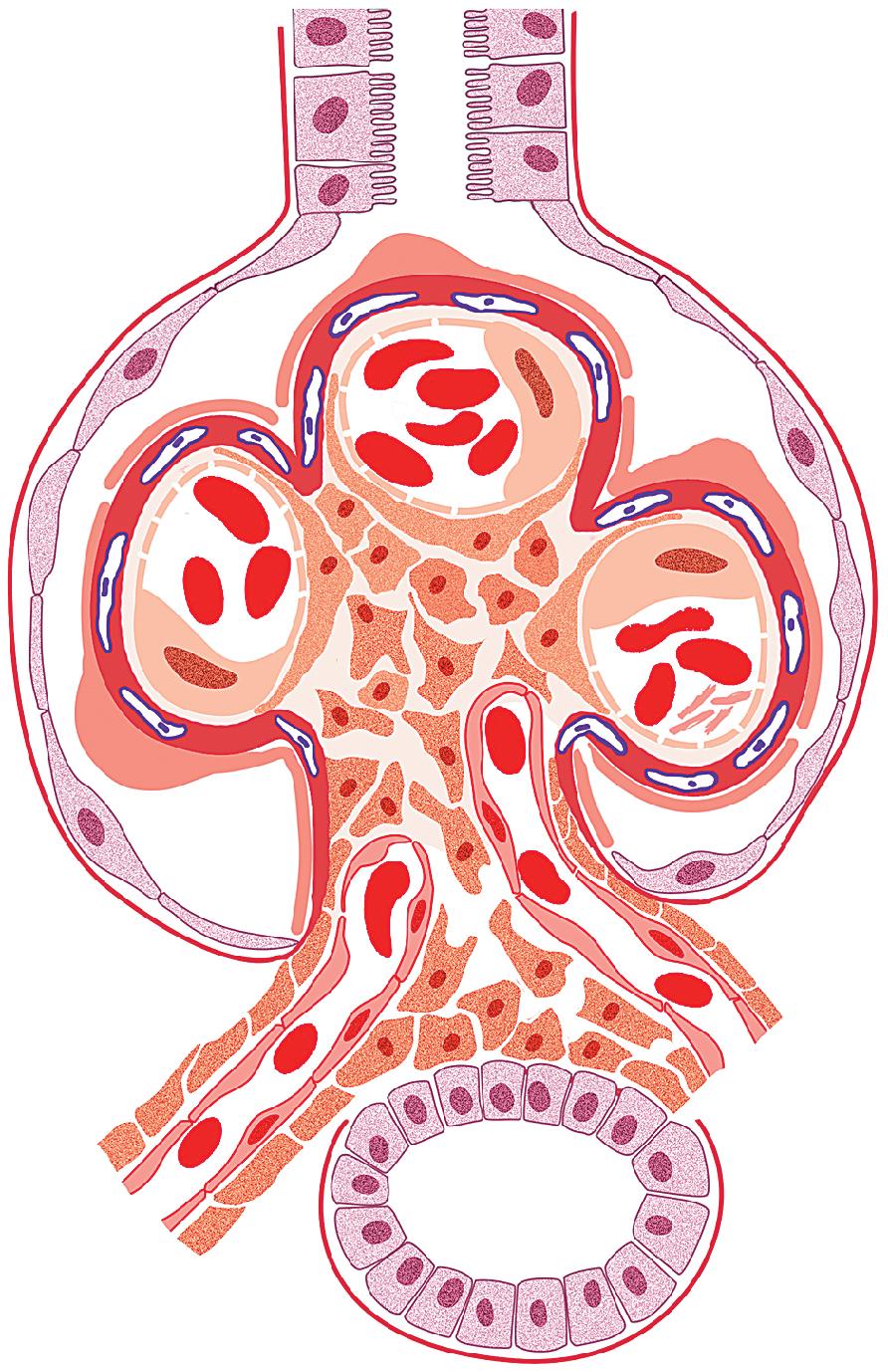
The pathologic findings can be divided into those that predominantly affect the glomeruli and those that predominantly affect the arteries and arterioles. Furthermore, they can be analyzed as the lesions seen early after the onset of the disease versus those that are more prominent after the disease progresses. The lesions of the thrombotic microangiopathies can show a wide range of changes according to both the severity and duration of disease. The basic morphologic changes are similar in most cases regardless of the cause and relate to the presence of endothelial injury and the subsequent activation of the coagulation system. The injury may be thrombotic or microangiopathic without thrombosis (i.e., without fibrin within the vascular lumen). The latter occurs especially in the chronic stage.
In the early stages, glomeruli show thickening of the capillary walls caused by endothelial cell swelling and the accumulation of material between the endothelial cell and the underlying basement membrane ( Figs. 4.20–4.22 ). By light microscopy the capillary walls show a double contour on silver stains (Fig. 4.23 ), and by EM, this is demonstrated to correspond to acellular fibrillar material in the subendothelial region ( Fig. 4.24 ). The term bloodless glomeruli has been used to characterize glomeruli in which the capillary loops are collapsed and may contain fragmented red blood cells, fibrin, and platelet thrombi ( Fig. 4.25 ). Fibrinoid necrosis in the afferent arteriole as it enters the glomerulus, usually associated with thrombosis, is also characteristic of the early phase ( Fig. 4.26 ). Generally, no increase in glomerular cellularity is seen. The mesangium may demonstrate loss of its architecture with apoptosis of mesangial cells, a process that has been termed mesangiolysis ( Figs. 4.27 and 4.28 ). Partial or complete dissolution of the mesangial matrix and cells results in the development of an aneurysmal dilation of the capillaries ( Fig. 4.29 ). Ischemic glomerular injury characterized by collapse of capillary loops and thickening and wrinkling of the capillary walls is prominent when there are severe acute vascular lesions, including thrombosis of arterioles and arteries ( Figs. 4.30 and 4.31 ). When necrosis of the glomerular capillaries occurs, small crescents may also be seen. As the lesion progresses, both a proliferative and sclerotic response can be seen individually and combined within the glomeruli ( Fig. 4.32 ). Areas of mesangiolysis progress into sclerotic changes; proliferation of intrinsic glomerular cells and laying down of new basement membrane material can yield a membranoproliferative pattern that in some cases is indistinguishable by light microscopy from membranoproliferative glomerulonephritis caused by deposits ( Fig. 4.33 ). Examination by IF and EM allows correct classification as to the cause of the GBM double contours.
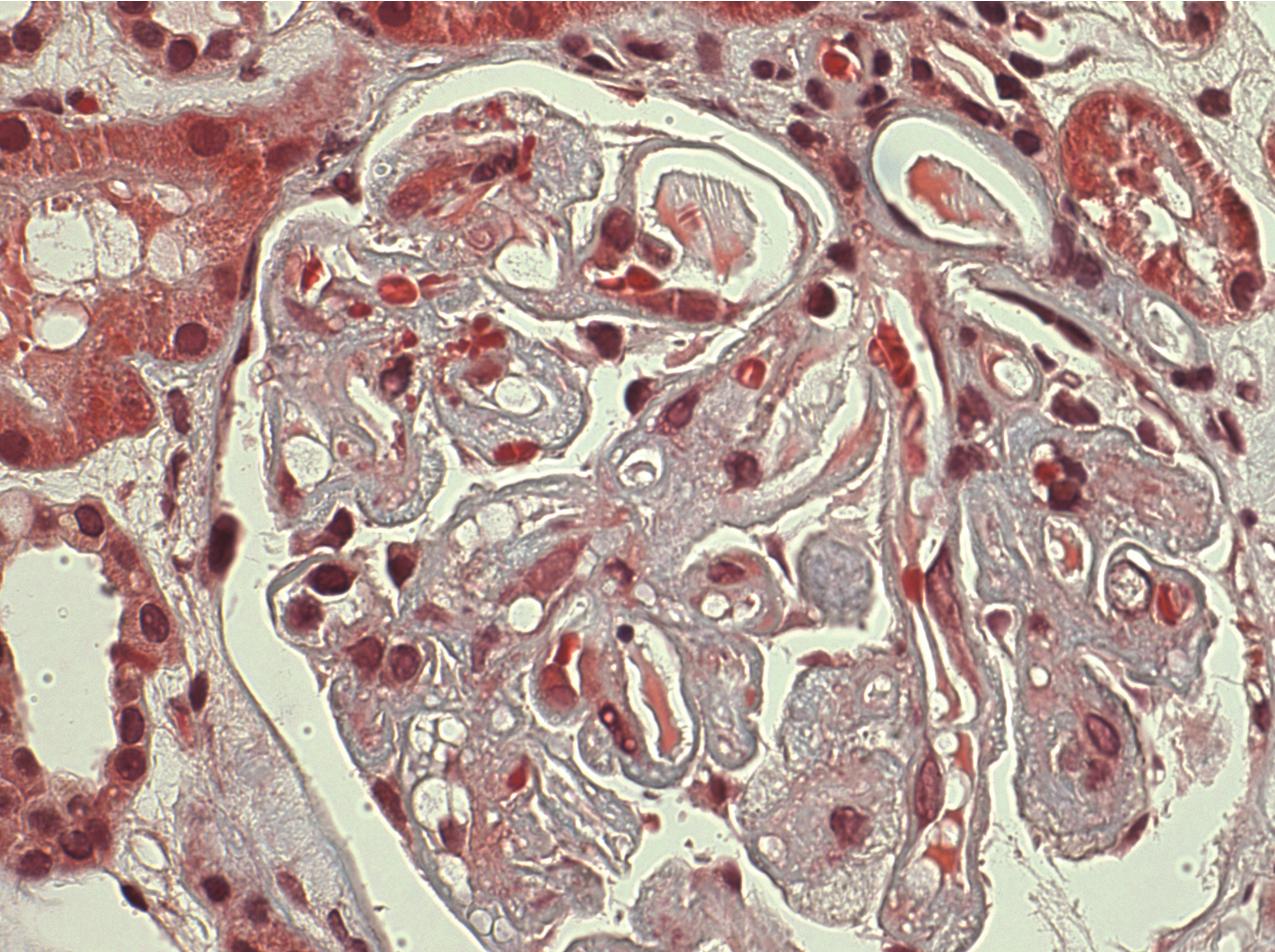

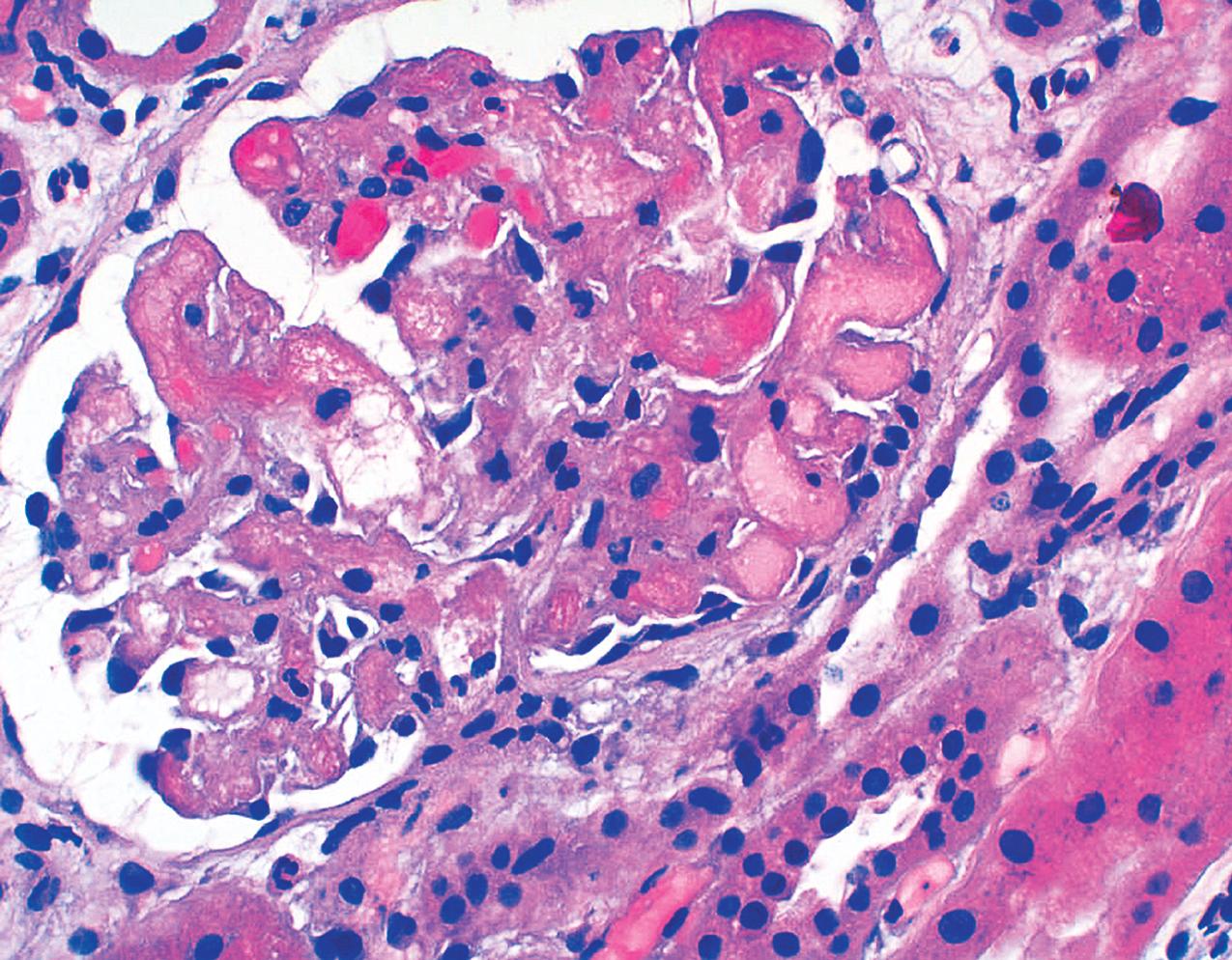
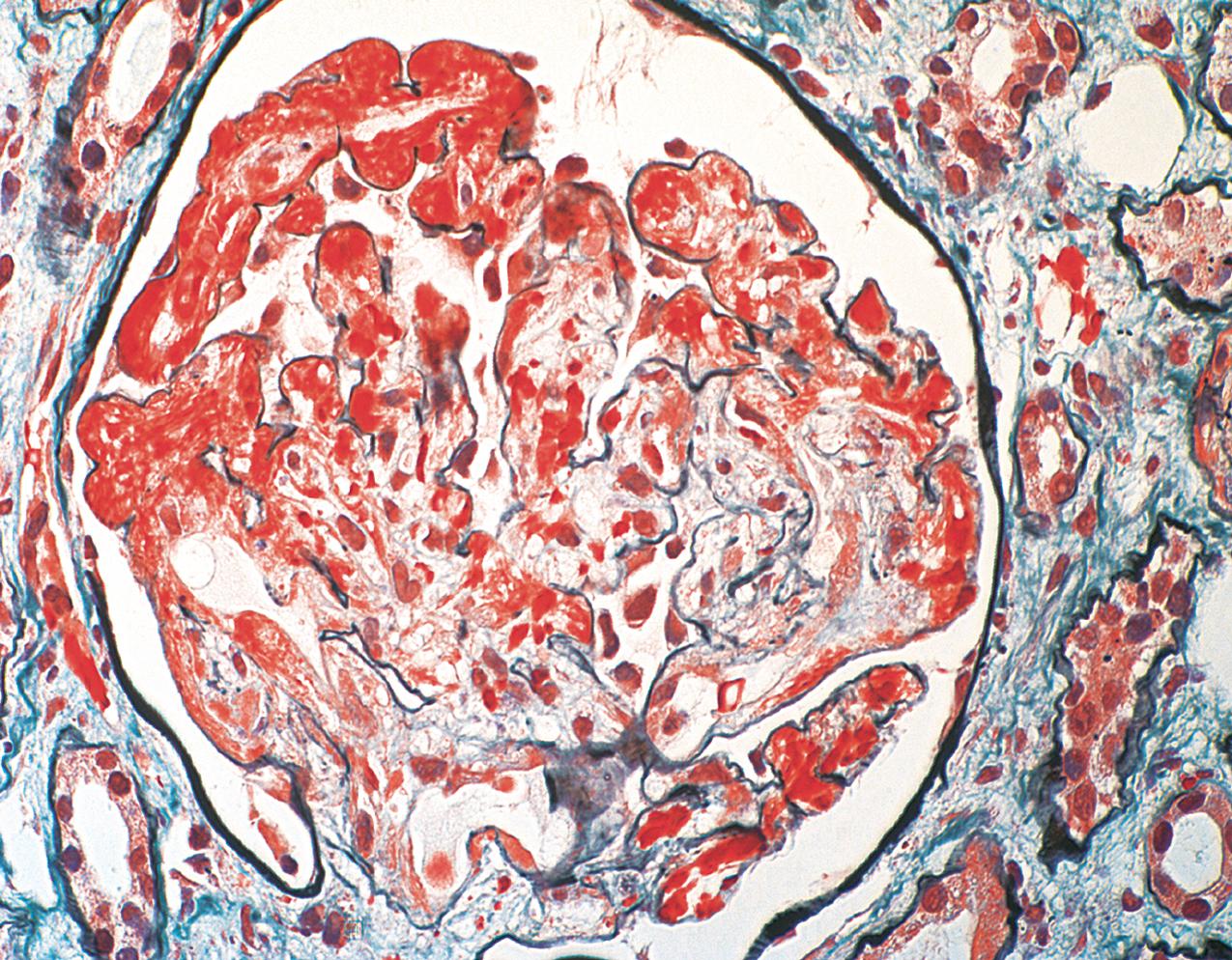
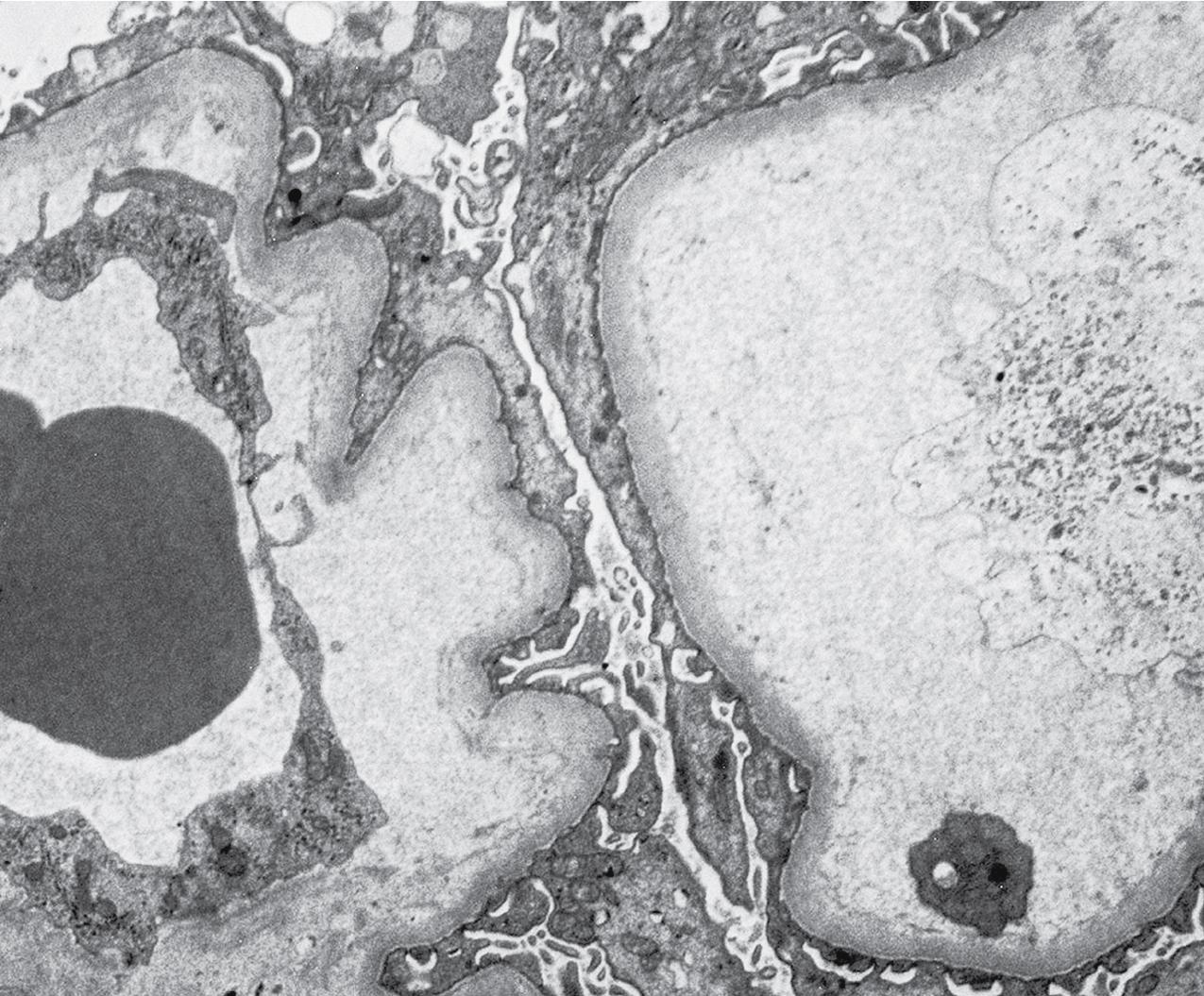
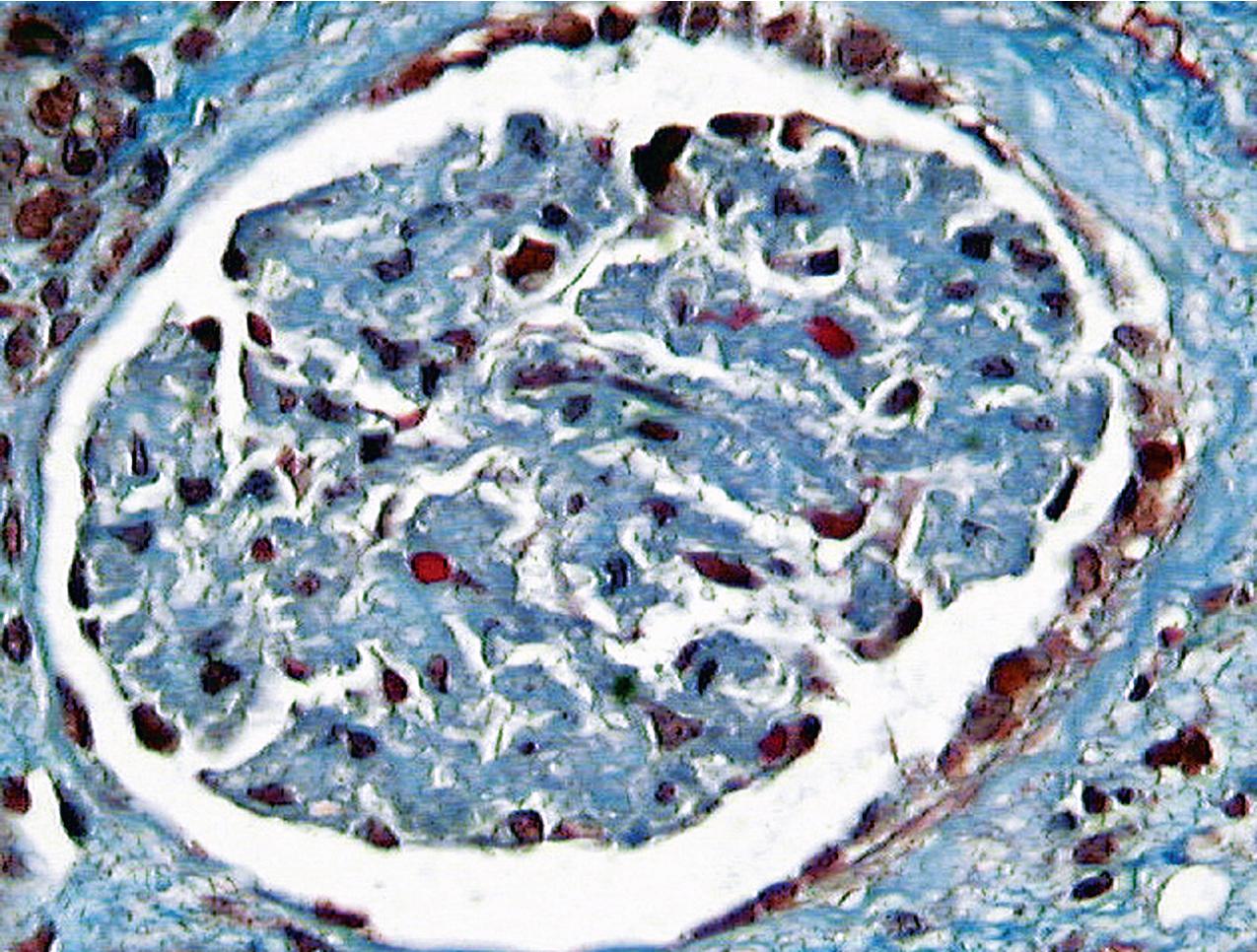
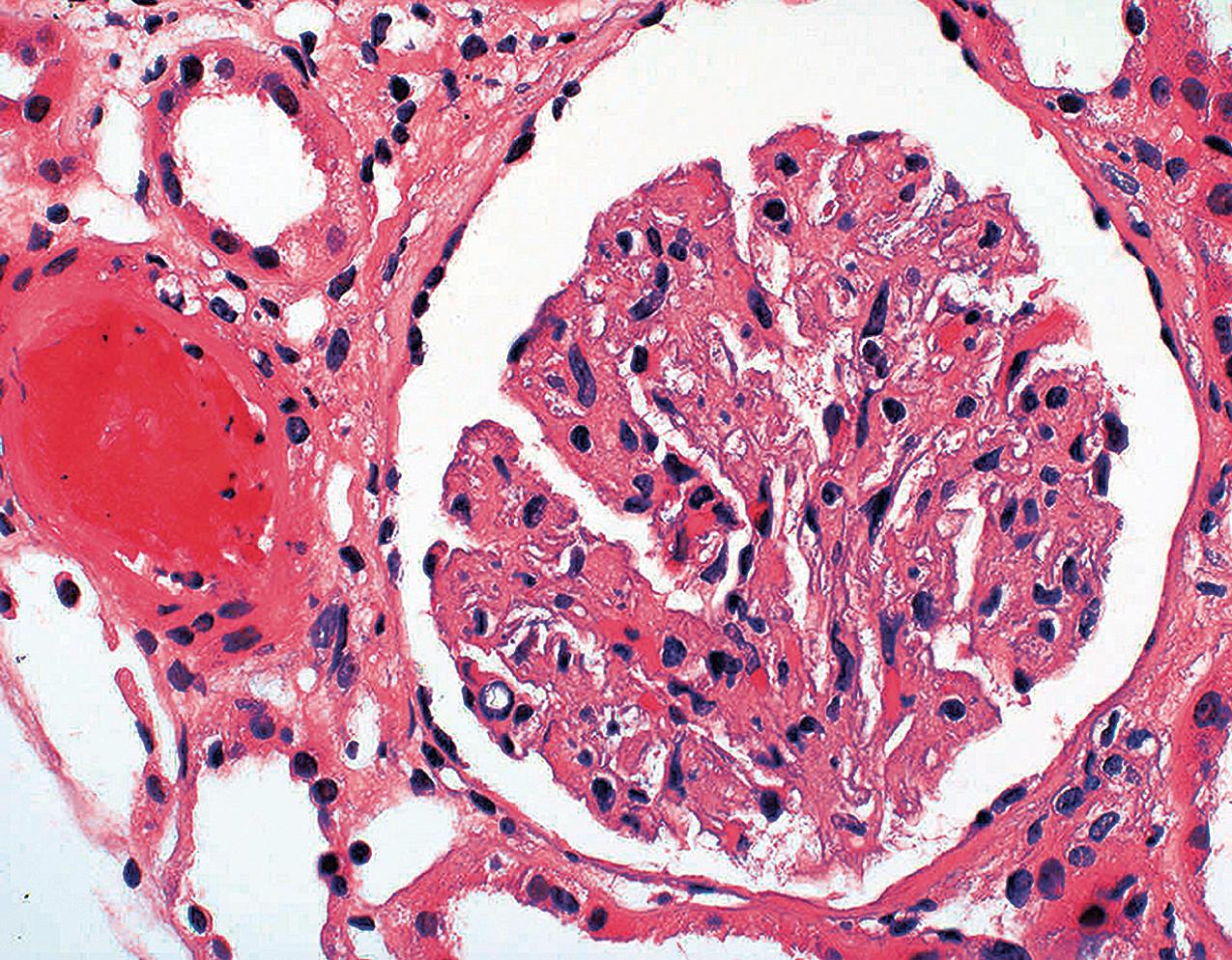
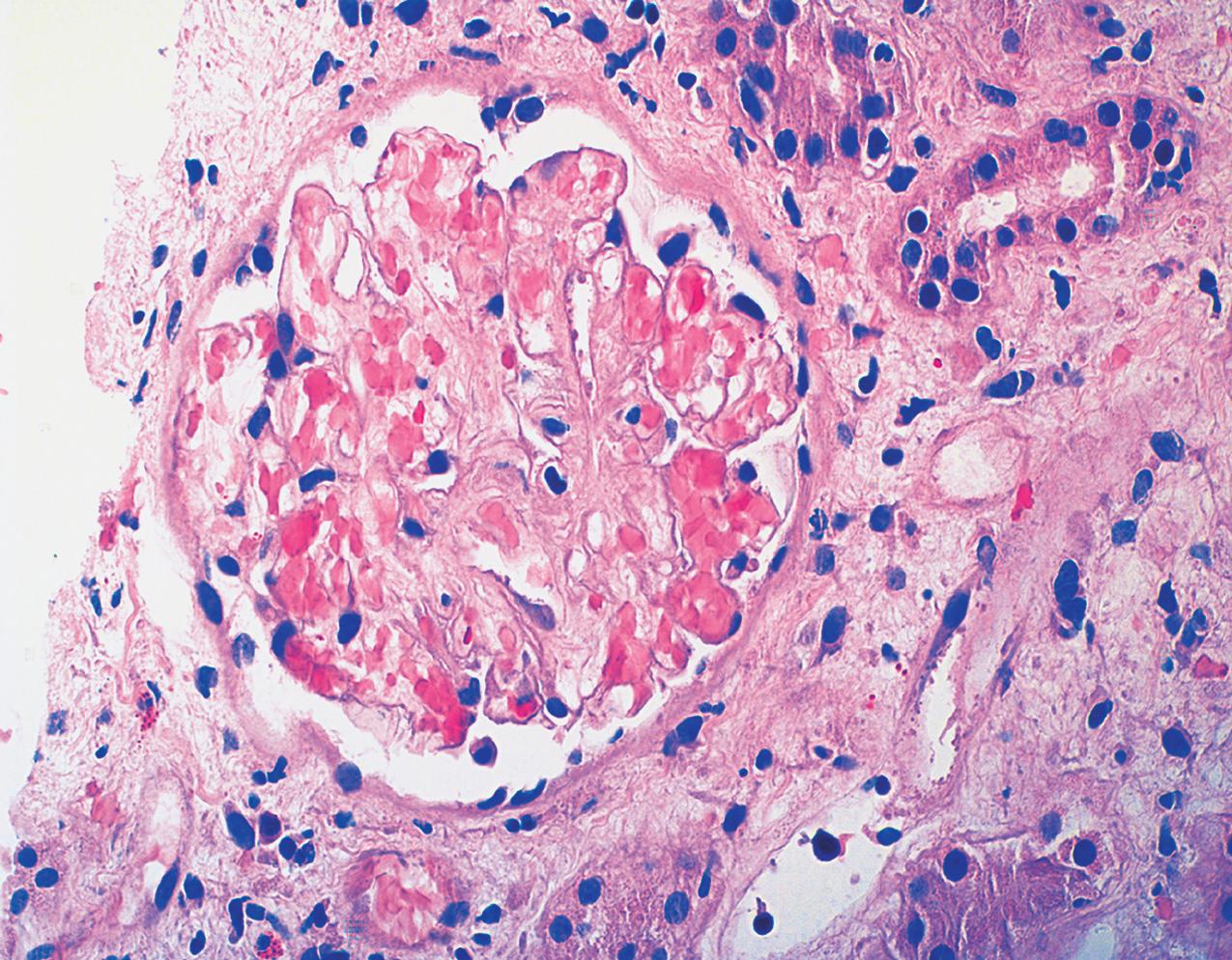
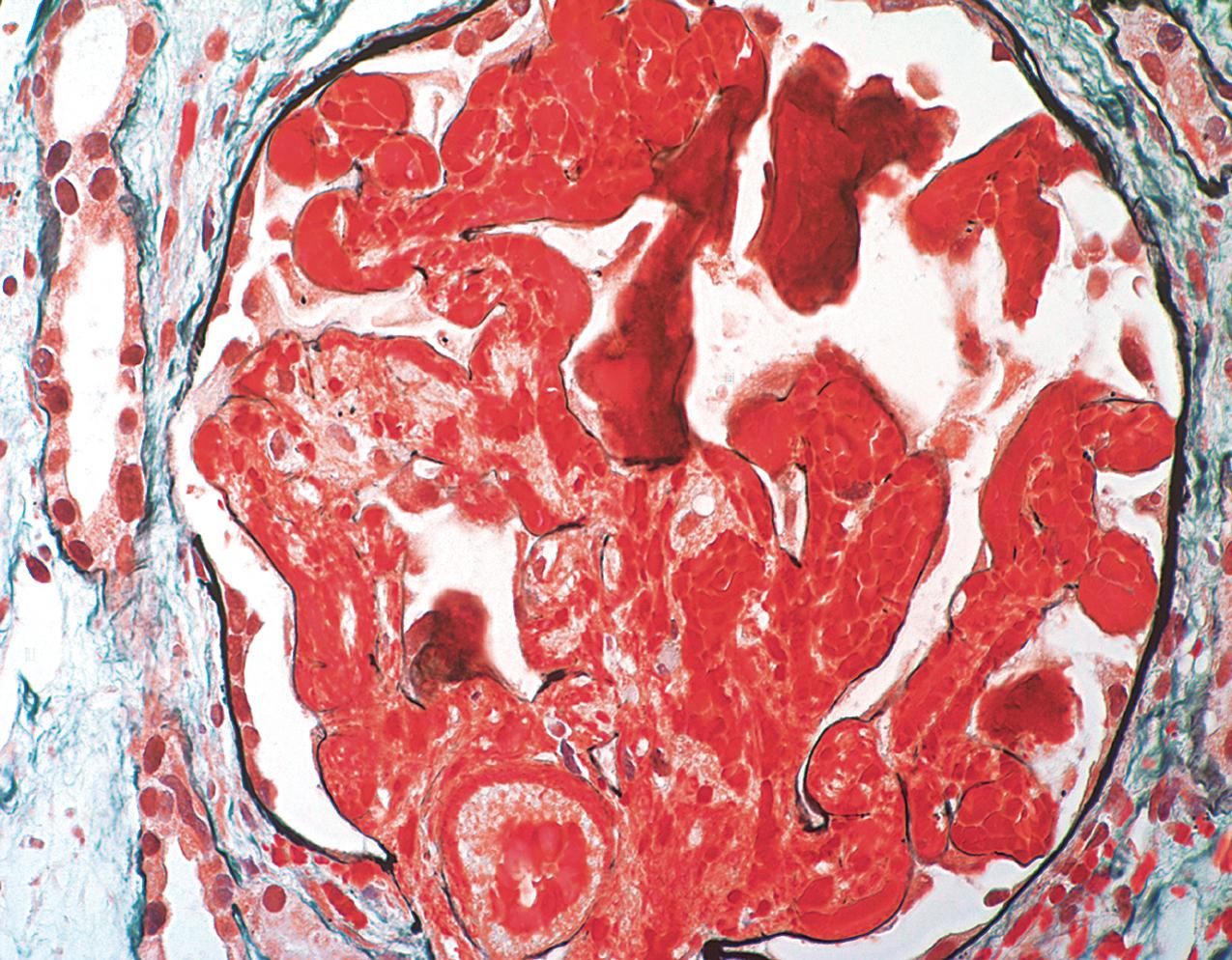
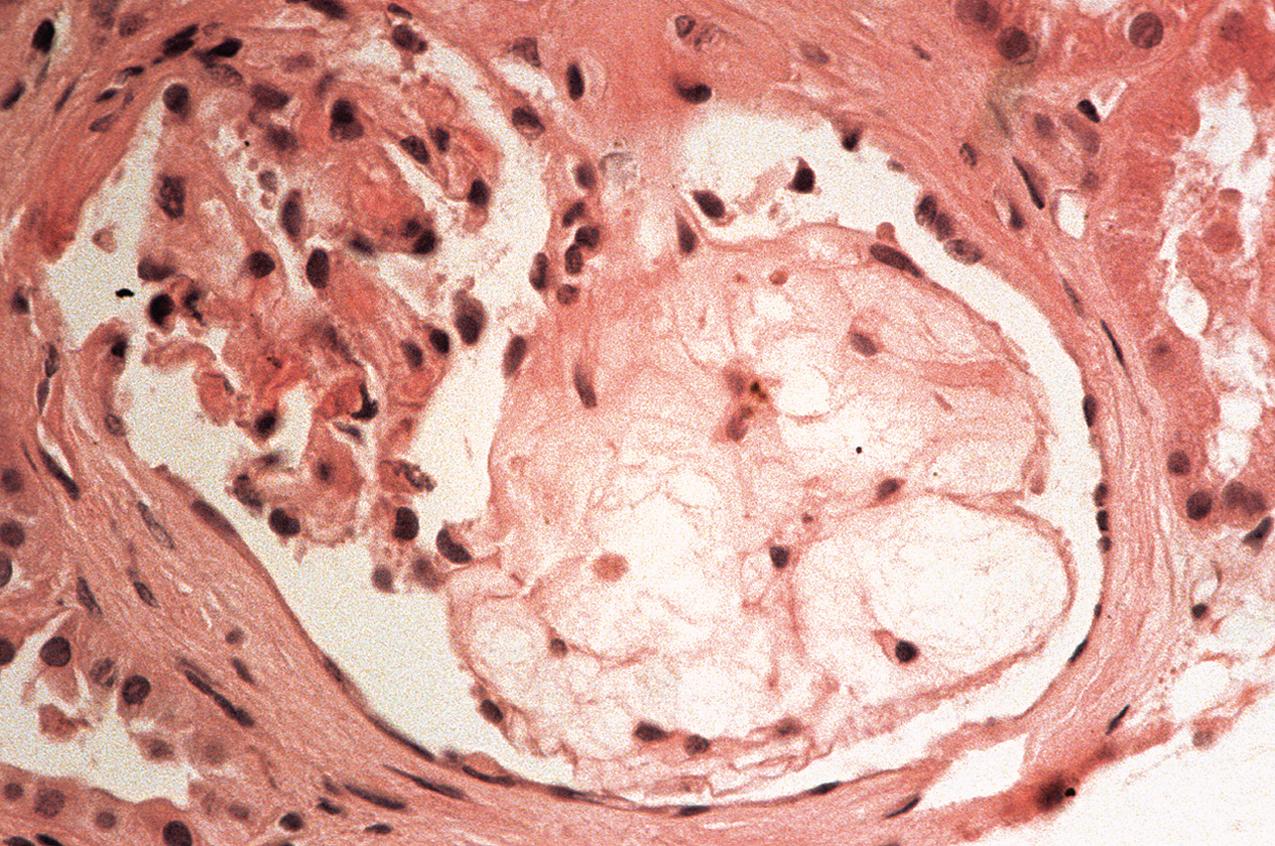
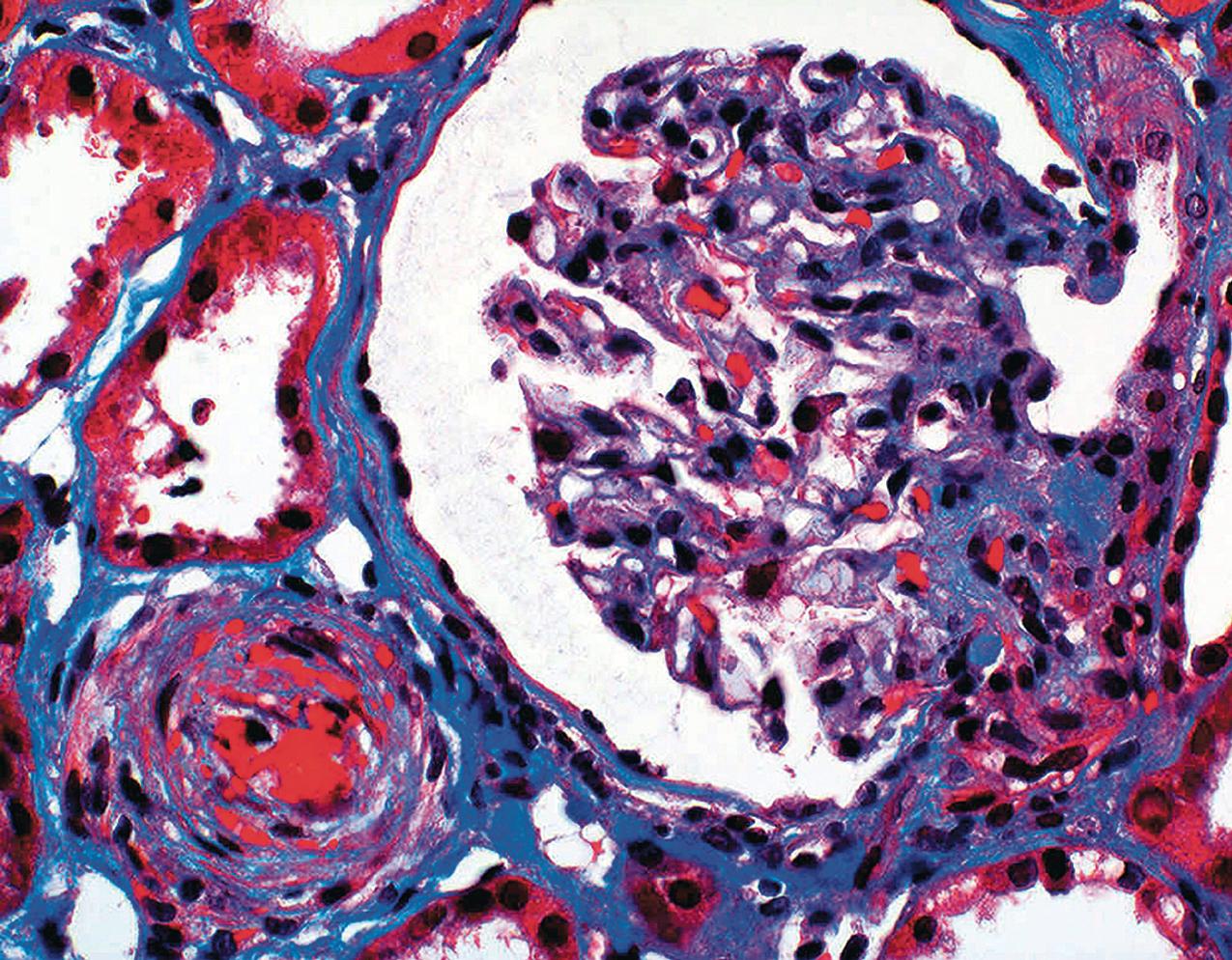
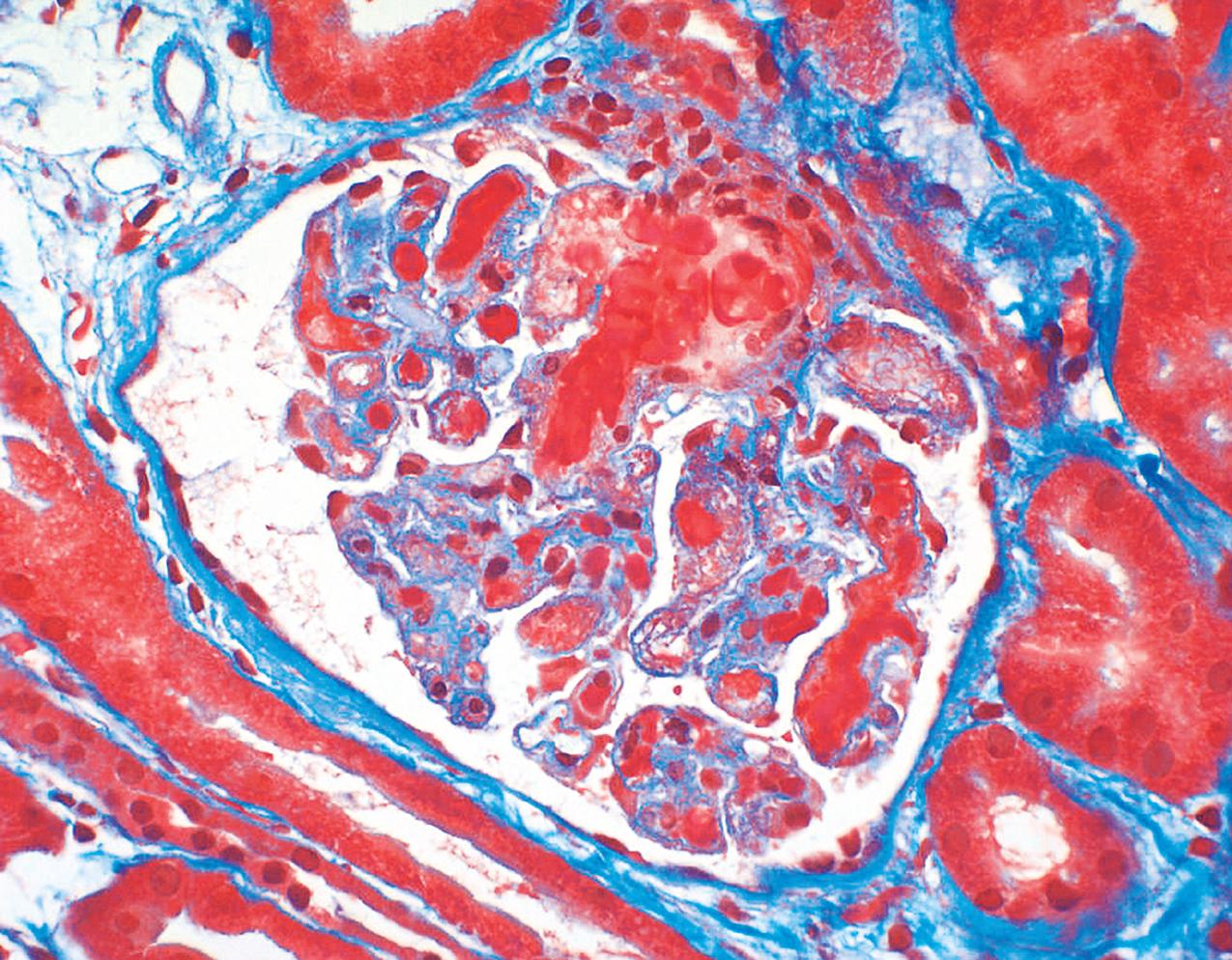
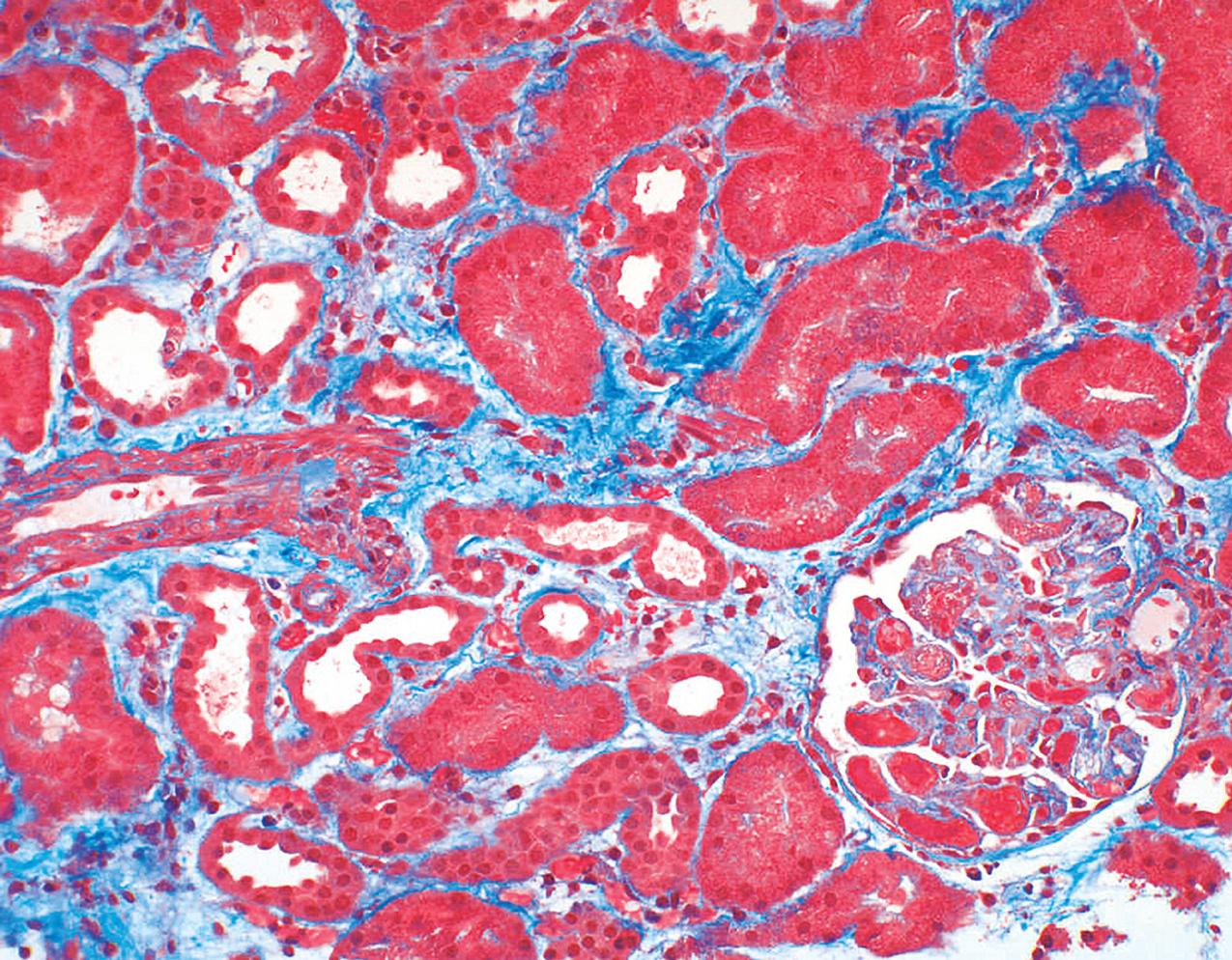
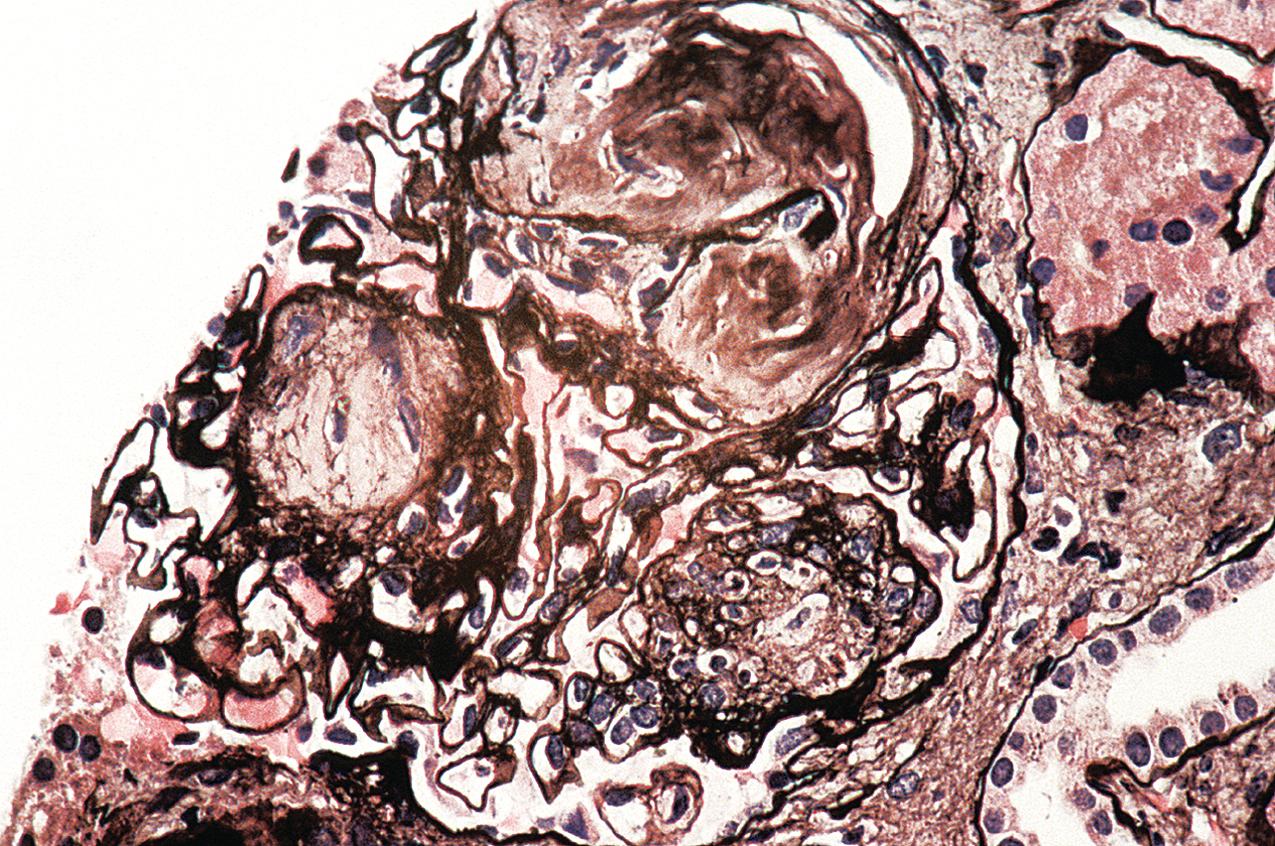
The acute arterial changes can range from mild, with swelling of the endothelium, to severe, with evidence of fibrinoid necrosis of the media with or without thrombosis of the lumen ( Fig. 4.34 ). As the disease progresses, there is myointimal proliferation with narrowing of the lumen, the so-called onion-skinning lesions , which involves the interlobular and arcuate arteries ( Fig. 4.35 ). Myointimal cells have a swollen appearance. This lesion has been termed mucoid intimal hyperplasia and is highly characteristic of thrombotic microangiopathies. As the lesion advances, duplication of the internal elastic lamella occurs with permanent compromise of the vascular lumen. This phase is often associated with severe hypertension. These vascular lesions should more correctly and logically be termed “microangiopathy” when there are no fibrin thrombi present.
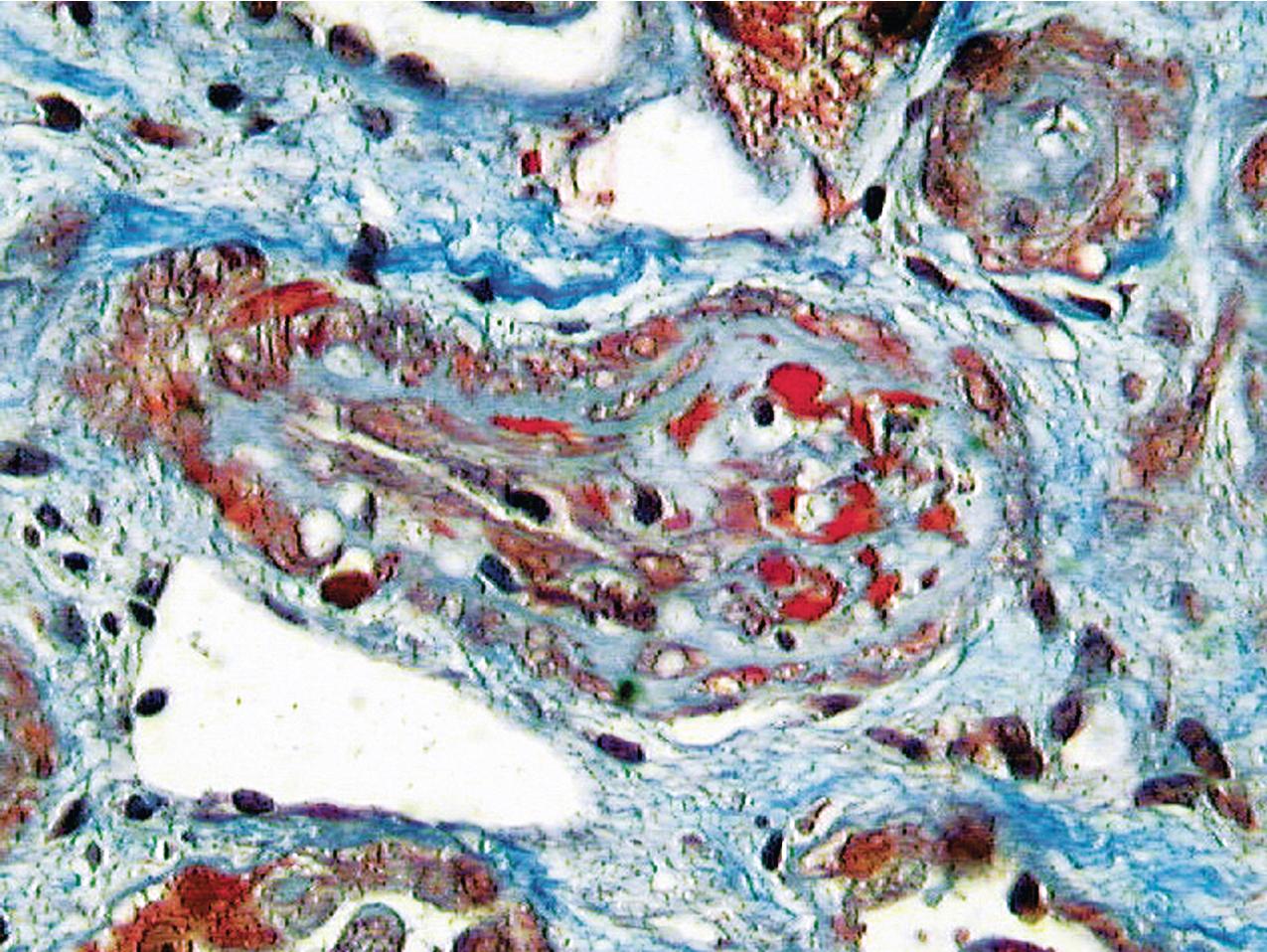
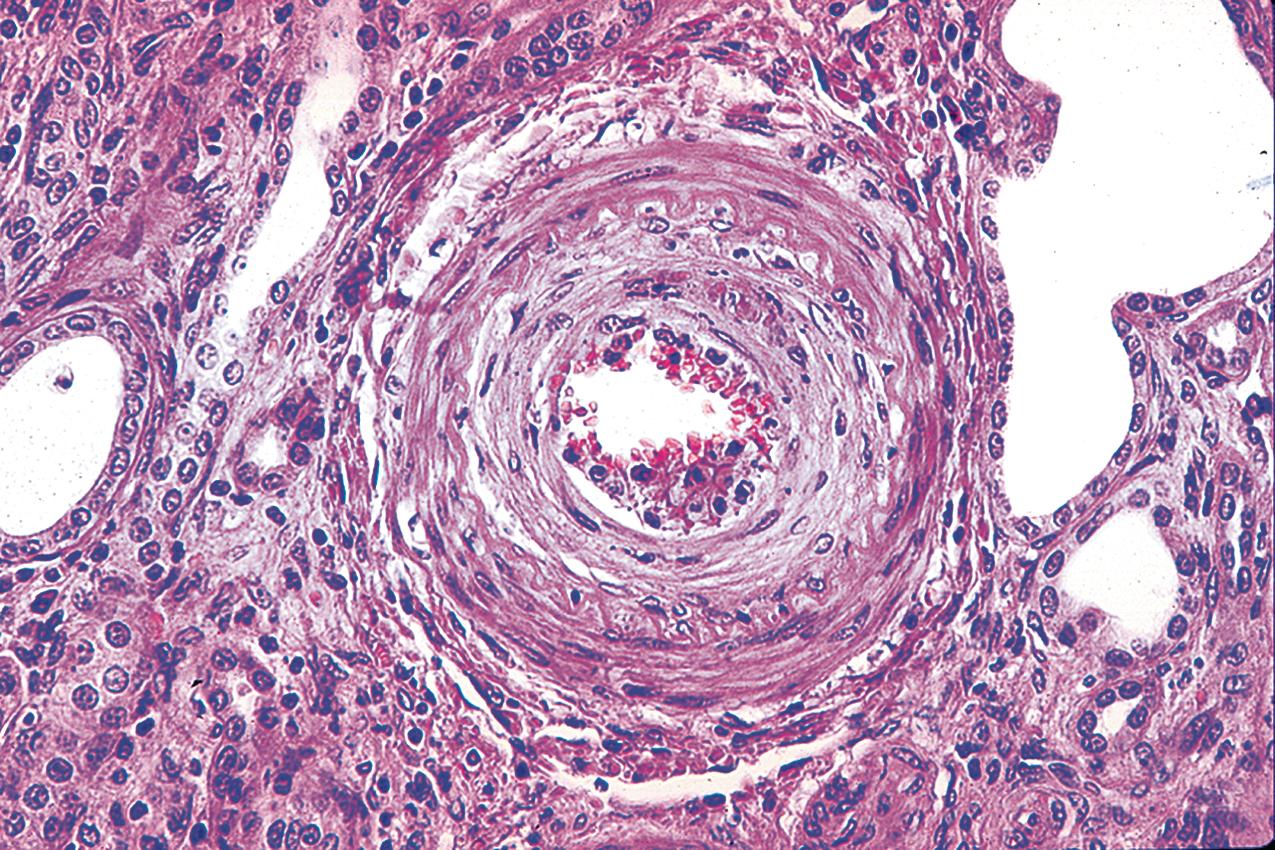
Tubular and interstitial changes are secondary to the glomerular and vascular lesions. There is often tubular collapse, occasionally associated with focal tubular necrosis. Patchy necrosis and true cortical infarcts are also occasionally present in severe cases. The interstitium shows fibrosis proportional to the tubular atrophy in the chronic stages.
IF microscopy demonstrates the deposition of fibrin and/or fibrinogen in the glomeruli and in the mesangium as well as within the vessel walls ( Fig. 4.36 ). Occasionally, nonspecific deposition of other immunoglobulins and complement may be seen.
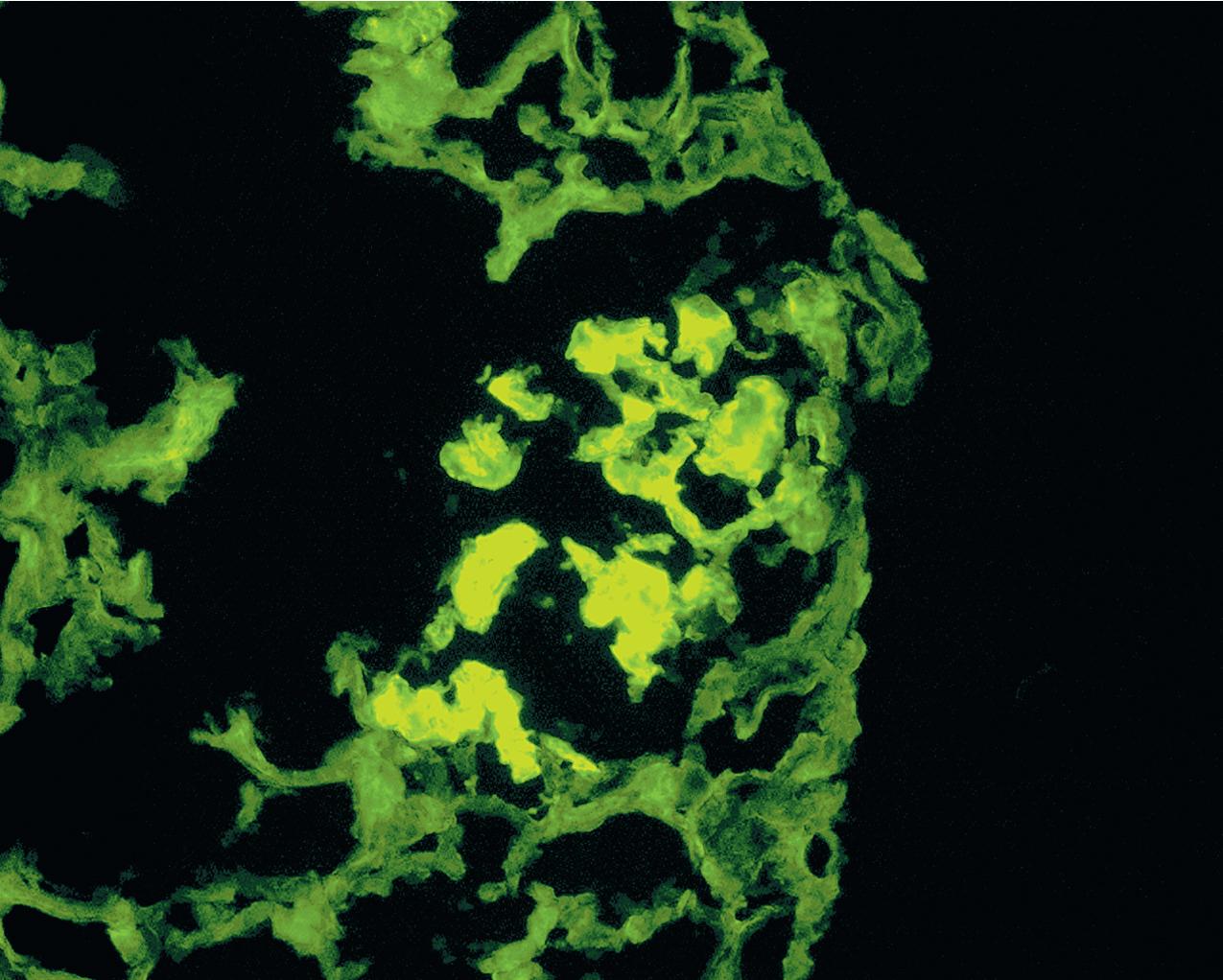
EM findings are consistent with those seen by light microscopy and IF. Early lesions demonstrate the separation of the endothelium from the GBM and the accumulation of subendothelial fibrillar material that corresponds to the presence of fibrinogen ( Figs. 4.37–4.40 ). Thrombosis of the capillary lumina with fibrin tactoids is also occasionally seen, as are accumulations of platelets. Endothelial cells in the glomeruli, arteries, and arterioles show swelling and separation from the underlying structures and evidence of apoptosis.
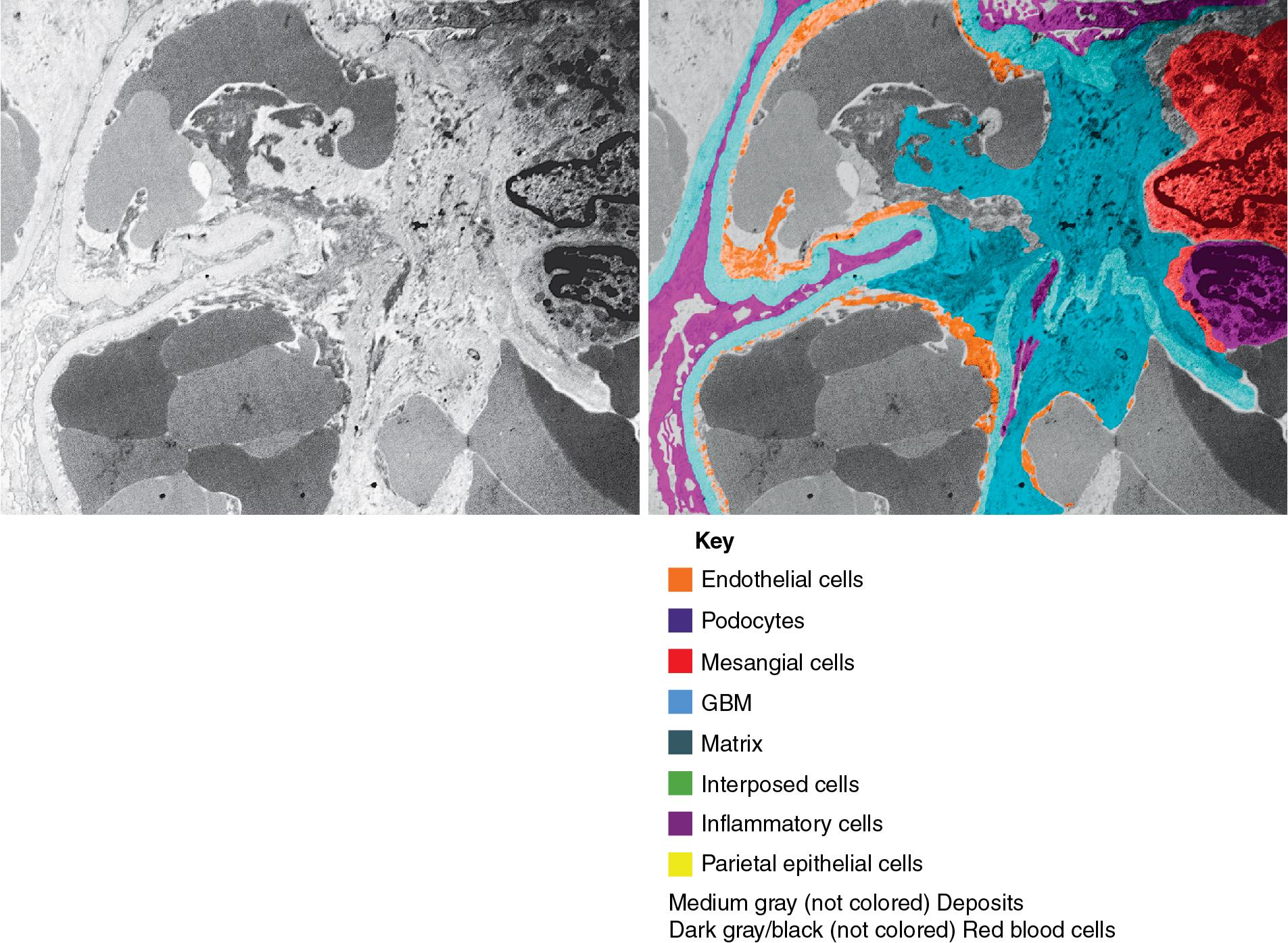
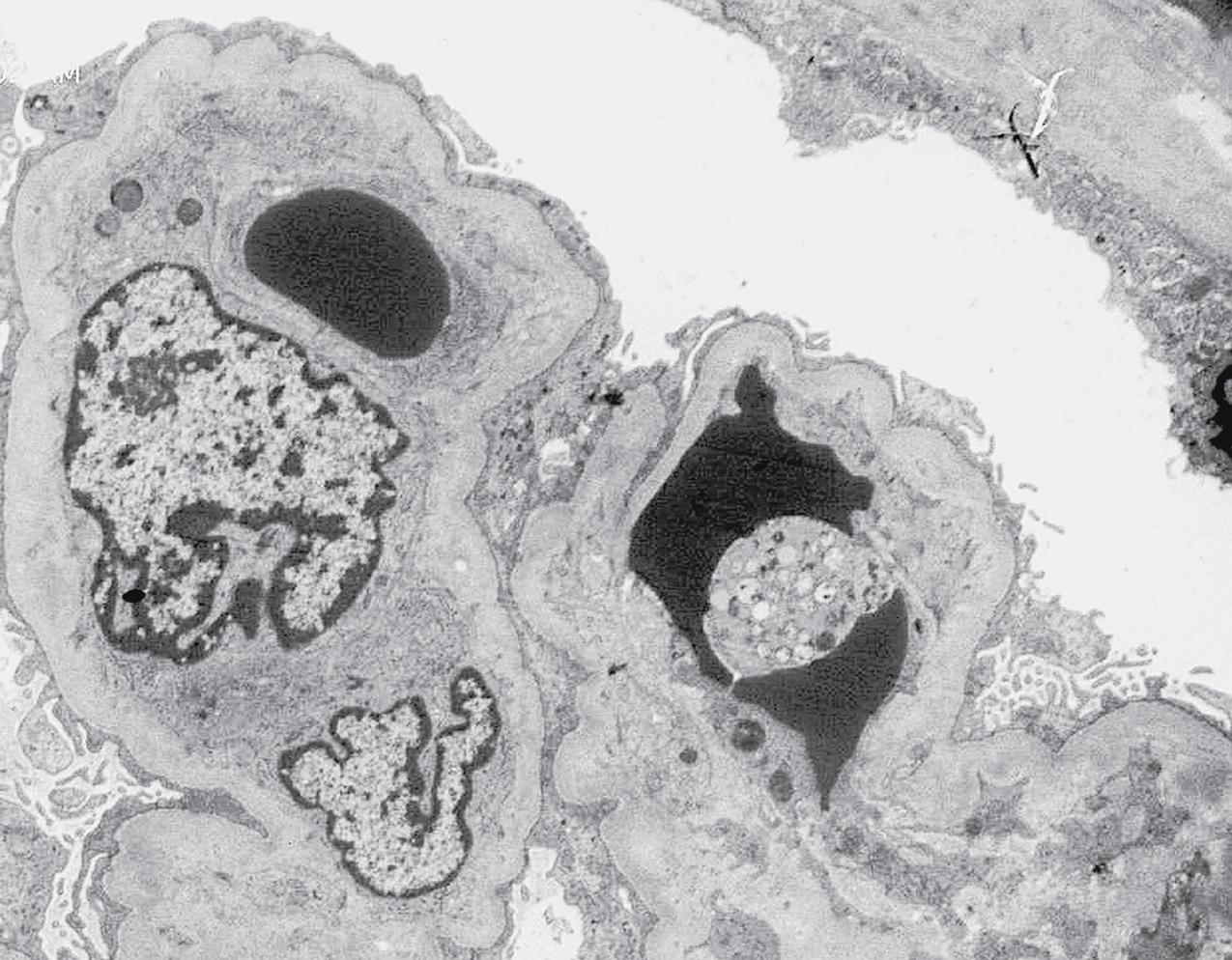
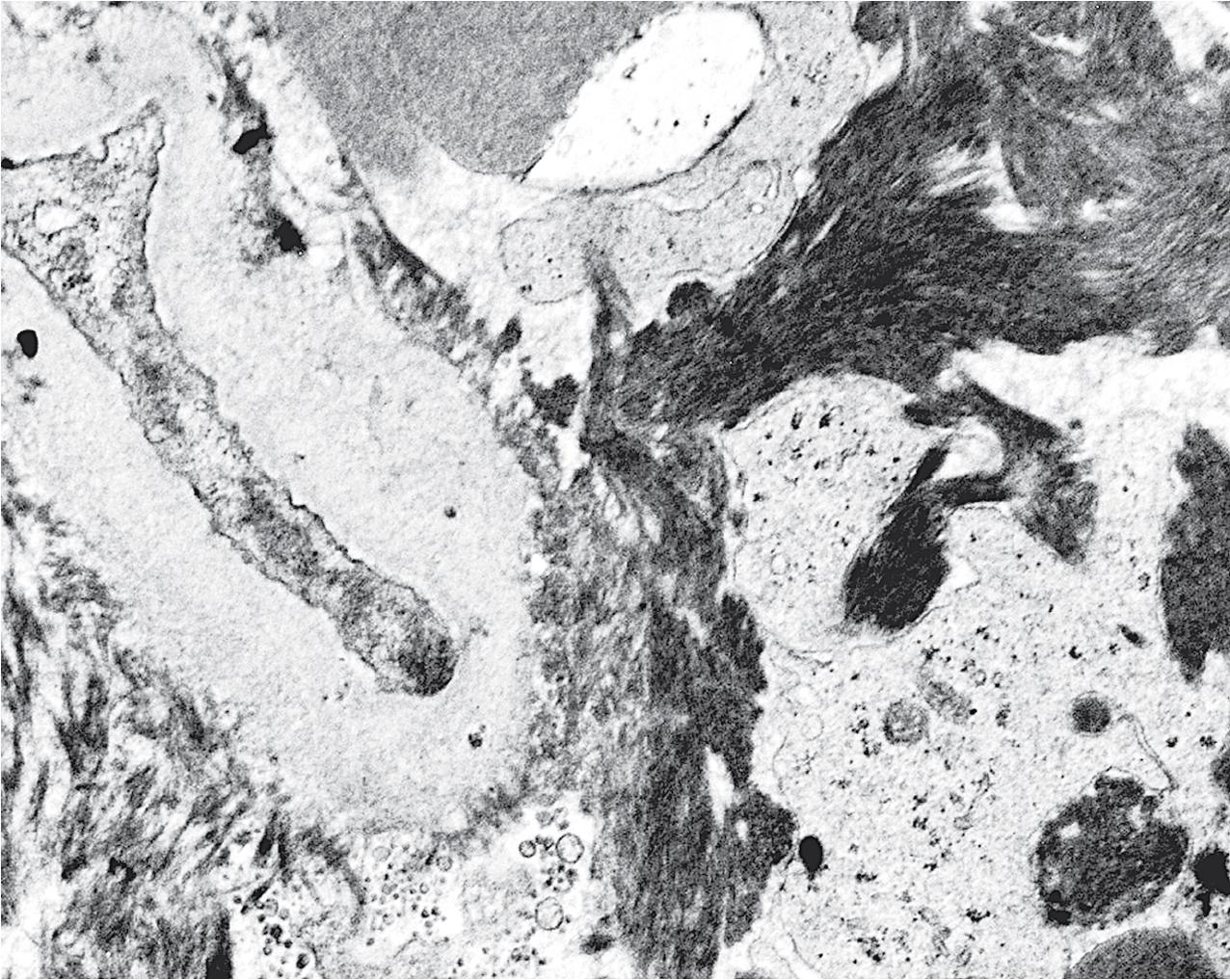
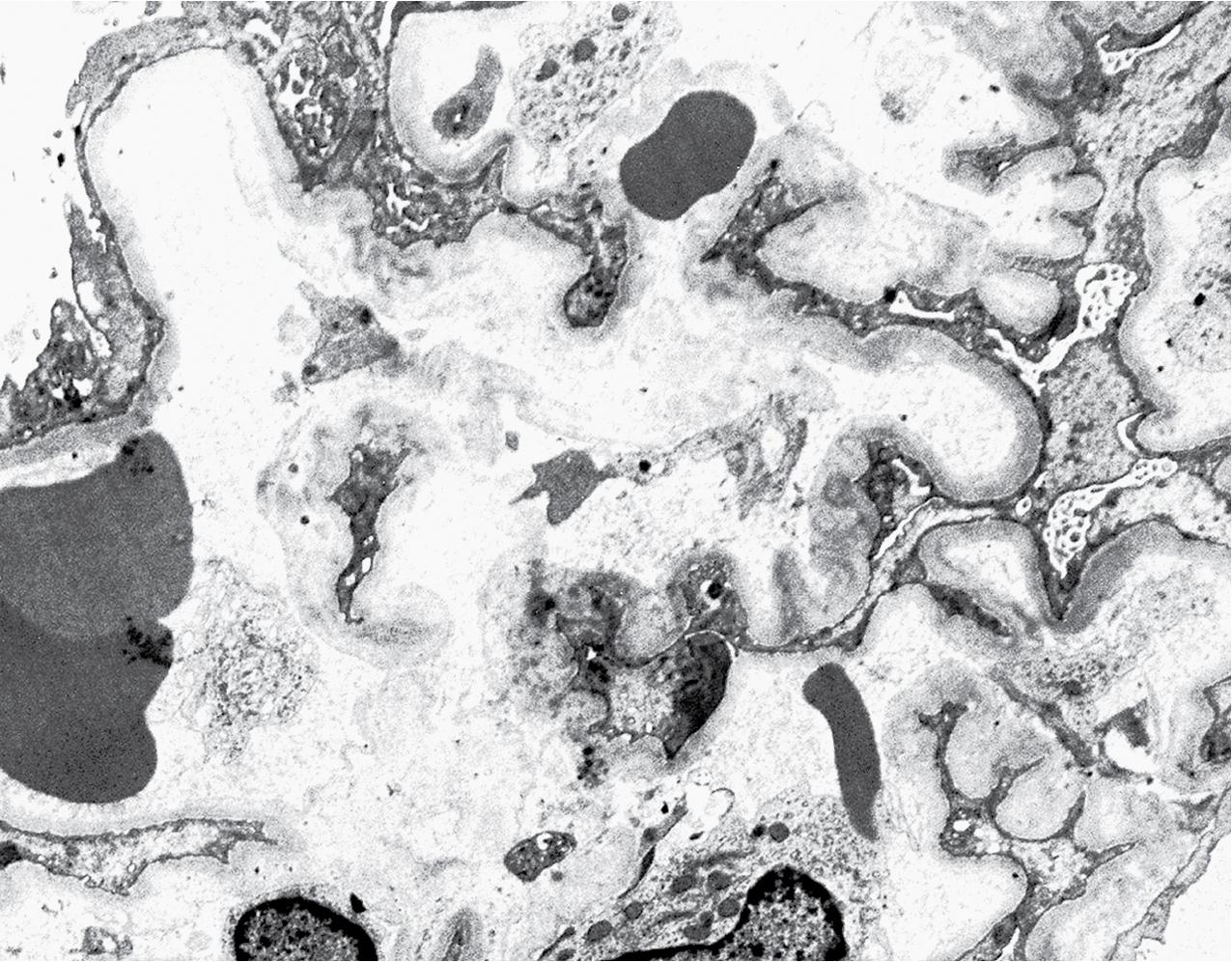
HUS can broadly be divided into individuals who present with diarrhea and those in whom diarrhea is not associated (aHUS). Non-diarrhea-associated disease can be further classified as sporadic or familial. Typical HUS (also referred to as HUS D +) are diarrhea-associated diseases secondary to infection with the Shiga toxin–producing bacteria Shigella dysenteriae and Escherichia coli strains 0157.H7 and more recently associated with multiple E. coli strains 0104.H4, 011:H8, 0103:H2,0123, and O26. Rarely, HUS has been associated with other bacteria, including Streptococcus pneumonia . Pathogenic factors for these E. coli strains are the production of verotoxins and adhesion molecules, which facilitate the binding of the bacteria tightly to colonocytes as well as to endothelial and mesangial cells, facilitating the transfer of the toxins. A small percentage of cases of HUS are not preceded by diarrhea and are called atypical HUS (aHUS). This disease is most commonly secondary to dysregulation and overactivation of the alternative complement pathway. The sporadic form of the disease can be associated with pregnancy, systemic lupus erythematosus, HIV infection, and a variety of drugs, including oral contraceptives and cyclosporin or tacrolimus. Illicit IV injection of crushed Opana, an oxymorphone, caused a surge of unusual cases of TMA with arteriolar/interlobular artery dominant necrosis and thrombosis, caused by direct endothelial cell toxicity of the pill matrix coating, intended to prevent dissolution and IV drug abuse. The form of this group of disorders called TTP has been linked to abnormalities of the metalloproteinase that is responsible for the breakdown of large von Willebrand factor aggregates or multimers into smaller, less active multimers (now called a disintegrin and metalloprotease with thrombospondin type motifs-13 , or ADAMTS-13). There may be a hereditary deficiency or an acquired antibody inhibitor of this protease. The absence of the protease results in an excess of von Willebrand factor multimers on endothelial cells, which are prothrombotic by promoting platelet aggregation. Familial TTP/HUS can be caused by a deficiency in ADAMTS-13. Other genetic forms of aHUS have been associated with mutations or copy number variations and other complex genomic rearrangements in complement regulatory factors (e.g., complement factors H, I, B, C3, CD46, and others). Deficiencies of these factors can also be the result of autoantibody inhibition, particularly noted for factor H (FH) autoantibodies. Mutations in diacylglycerol kinase epsilon (DGKE) as a cause of recessive infantile HUS characterized by proteinuria have highlighted podocyte dysfunction as a potential complication of aHUS. The use of VEGF inhibitors systemically in cancer therapy or intraocularly for treatment of proliferative retinopathy has identified a unique form of TMA where endothelial activation/injury plays a central role ( Figs. 4.41 and 4.42 ). VEGF originating from podocytes is crucial to maintain glomerular endothelial cells, and inhibition of VEGF by these drugs can result in endothelial injury and even TMA.
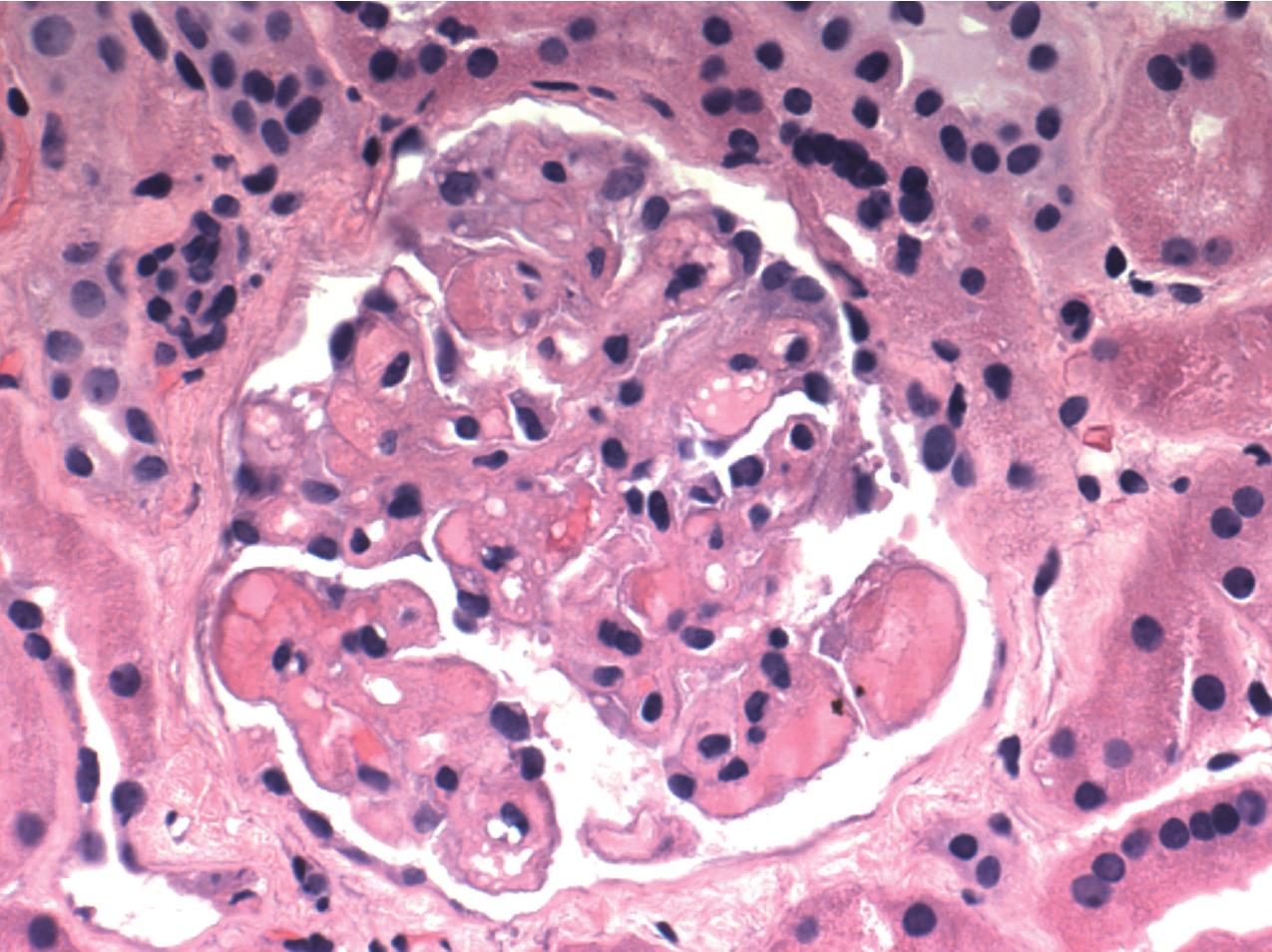
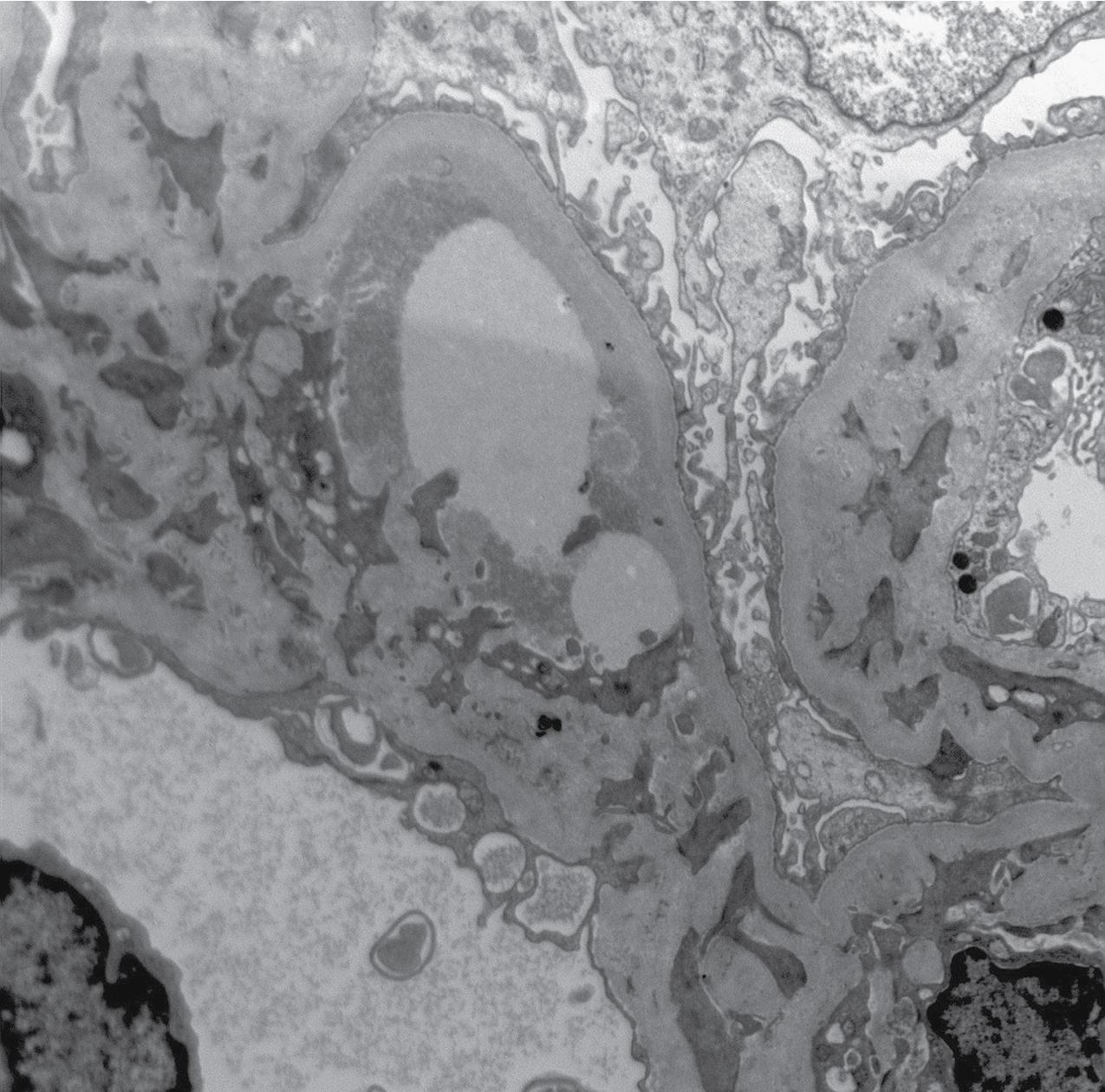
Intravascular fibrin thrombi in the acute stage
Double contours of GBMs with variable hypercellularity and no immune complexes in the chronic stage
Mucoid change of arterioles in the acute stage
Intimal proliferation of arterioles in the chronic stage (“onion-skinning”)
Fibrin may also occur associated with fibrinoid necrosis in, for example, vasculitis or crescentic glomerulonephritis.
Karyorrhexis and tissue destruction are then evidence of the primary necrotizing process underlying the injury, rather than an intracapillary thrombotic process.
Benz K, Amann K. Thrombotic microangiopathy: new insights. Curr Opin Nephrol Hypertens. 2010;19:242-247.
Churg J, Strauss L. Renal involvement in thrombotic microangiopathies. Semin Nephrol. 1985;5:46-56.
Eremina V, Jefferson JA, Kowalewska J, et al. VEGF inhibition and renal thrombotic microangiopathy. N Engl J Med. 2008;358:1129-1136.
George JN, Nester CM. Syndromes of thrombotic microangiopathy. N Engl J Med. 2014;371:654-666.
Goodship THJ, Cook TH, Fakhouri F, et al. Atypical hemolytic uremic syndrome and C3 glomerulopathy: conclusions from a Kidney Disease: Improving Global Outcomes (KDIGO) Controversies Conference. Kidney Int. 2017;91:539-551.
Hunt R, Yalamanoglu A, Tumlin J, et al. A mechanistic investigation of thrombotic microangiopathy associated with IV abuse of Opana ER. Blood. 2017;129:896-905.
Noris M. Terminal complement effectors in atypical hemolytic uremic syndrome: C5a, C5b-9, or a bit of both? Kidney Int. 2019;96:13-15.
Noris M, Mele C, Remuzzi G. Podocyte dysfunction in atypical haemolytic uraemic syndrome. Nat Rev Nephrol. 2015;11:245-252.
Shatzel JJ, Taylor JA. Syndromes of thrombotic microangiopathy. Med Clin North Am. 2017;101:395-415.
Systemic sclerosis (SS) is a multisystem disease that affects the skin, the gastrointestinal (GI) tract, the lung, the heart, and the kidney. Kidney involvement occurs in approximately 60% to 70% of SS patients. Age at onset of systemic sclerosis is 30 to 50 years, and females are affected more than males, with a slight predominance of African Americans versus Caucasians. Survival over 5 years in SS ranges from 34% to 73%, with scleroderma renal crisis being the most common cause of death. Scleroderma is now classified as limited or diffuse cutaneous scleroderma. In the limited form, fibrosis is mainly restricted to the hands, arms, and face, with Raynaud phenomenon preceding fibrosis, with frequent pulmonary hypertension. Most of these patients also have anticentromere antibodies. Diffuse cutaneous scleroderma is a more severe, rapidly progressing process that has adverse effects not only on large areas of skin but also on one or more internal organs. The kidneys, esophagus, heart, and lungs are the most frequently affected. Patients with renal involvement can have antitopomerase I and anti-RNA I, II, or III polymerase antibodies.
Scleroderma renal crisis develops in approximately 20% of patients with SS but may be decreasing because of early treatment with ACEIs. Patients present with severe hypertension and acute kidney injury. Grossly, petechial hemorrhages or even renal infarcts may be present in patients with scleroderma renal crisis, similar to HUS or severe hypertension. Microscopically, the major finding is a proliferative obliterative change of arteries and arterioles sometimes associated with fibrinoid necrosis of afferent arterioles. Fibrin can extend to glomeruli ( Figs. 4.43 and 4.44 ). Glomeruli may show ischemic collapse or fibrinoid necrosis ( Figs. 4.45 and 4.46 ; see also Figs. 4.43 and 4.44 ). Interlobular arteries show intimal thickening, proliferation of endothelial cells, and edema with mucoid change ( Figs. 4.47–4.49 ). RBC fragments are often present within the injured vessel wall, and there may be vessel wall necrosis and/or fibrin thrombi within vessels. Glomeruli may show ischemic collapse or fibrinoid necrosis. In chronic injury, there is duplication of the elastic internal lamina, that is, the so-called “onion-skin pattern” ( Figs. 4.50–4.53 ). Tubules may show degeneration and even necrosis, especially in scleroderma crisis (see Fig. 4.47 ). Tubulointerstitial fibrosis develops with chronic injury. There are no immune complexes, and EM shows only increased lucency of the lamina rara interna, similar to TMA ( Fig. 4.54 ).
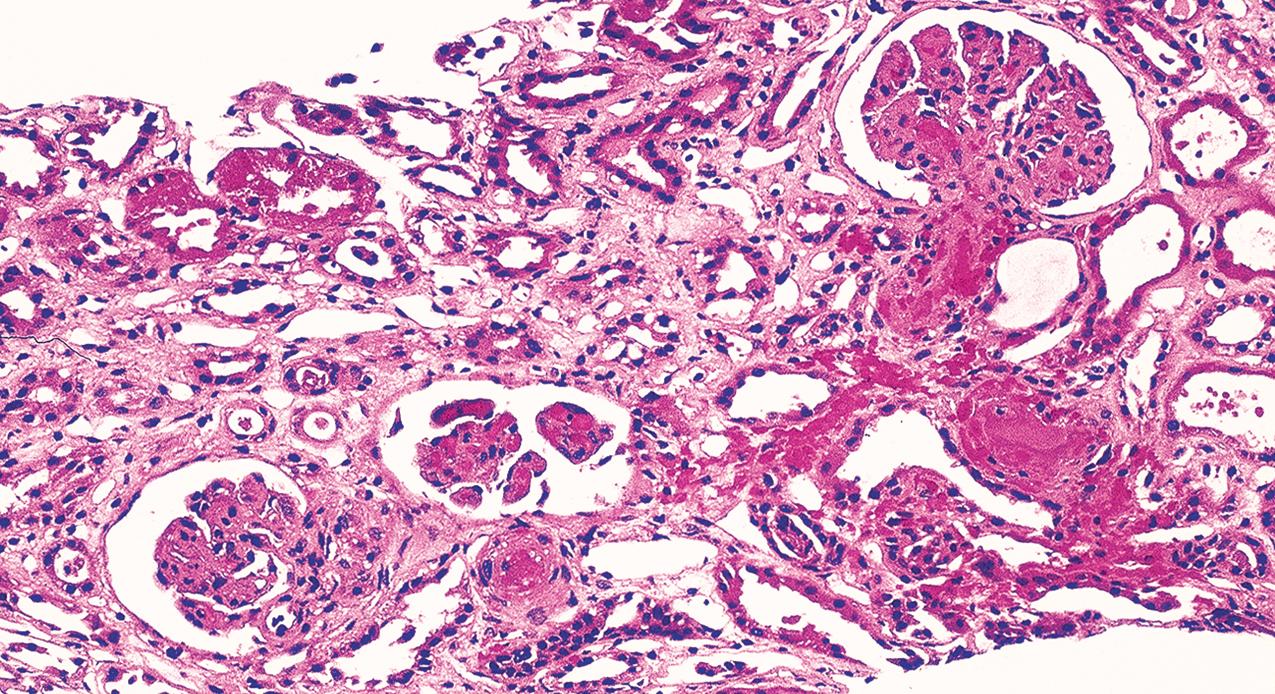
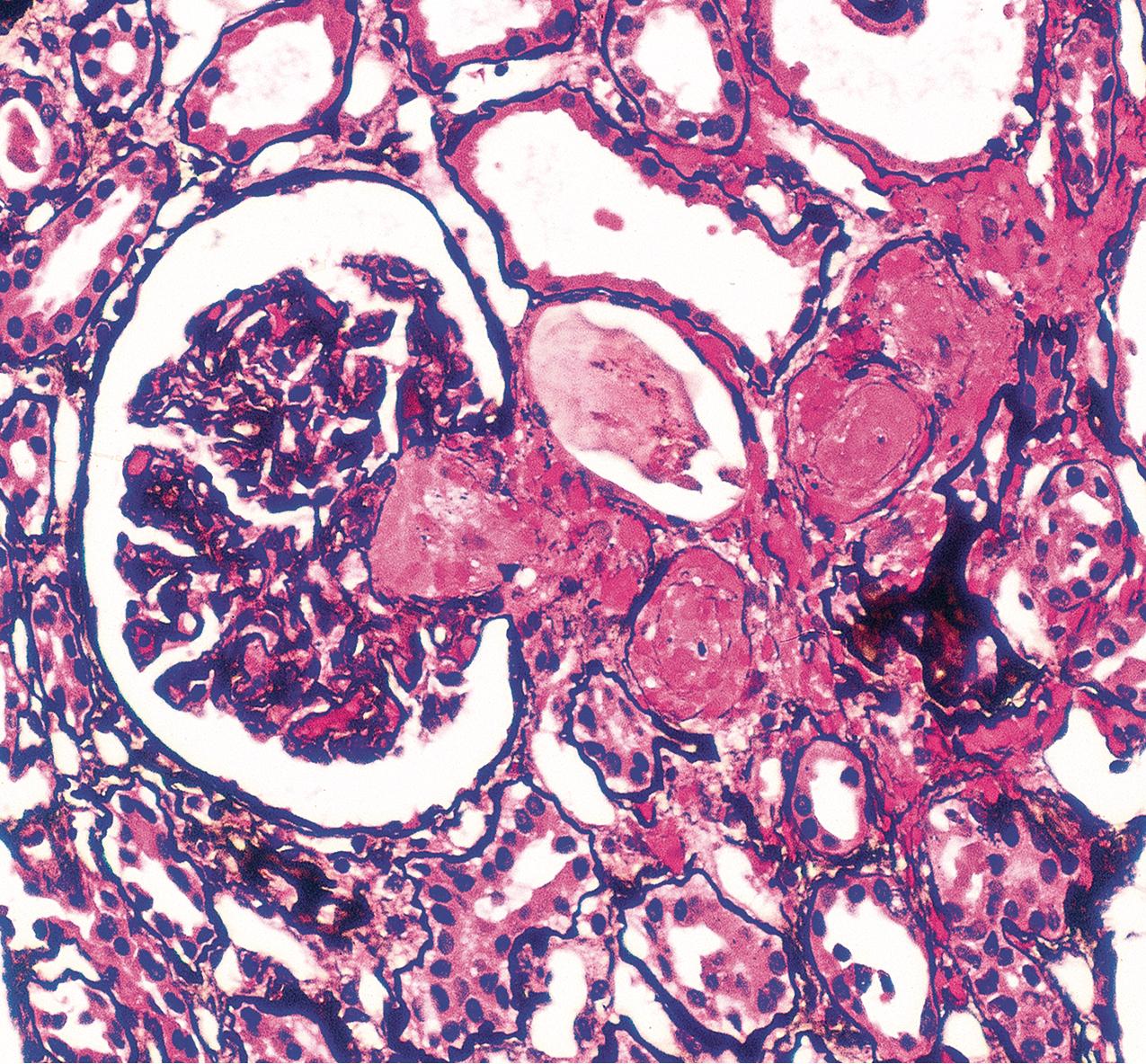

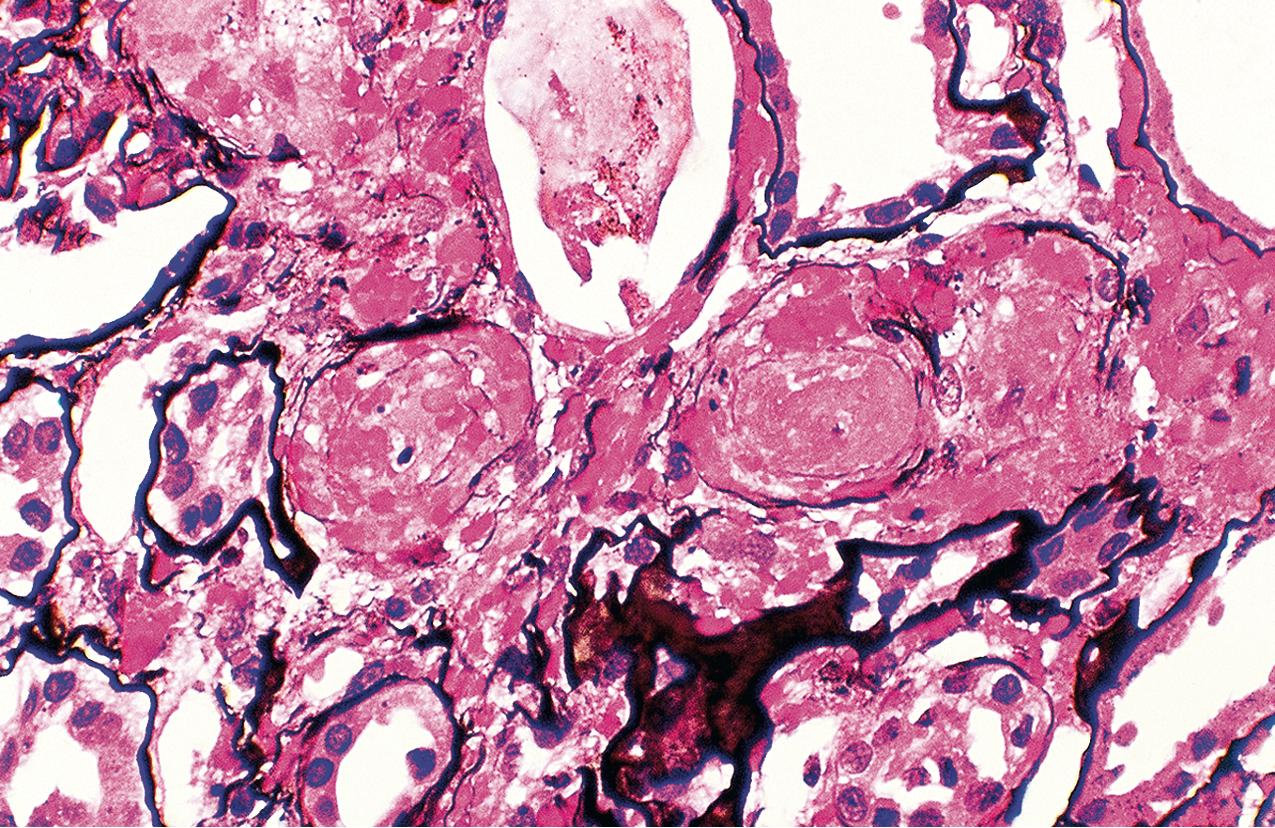
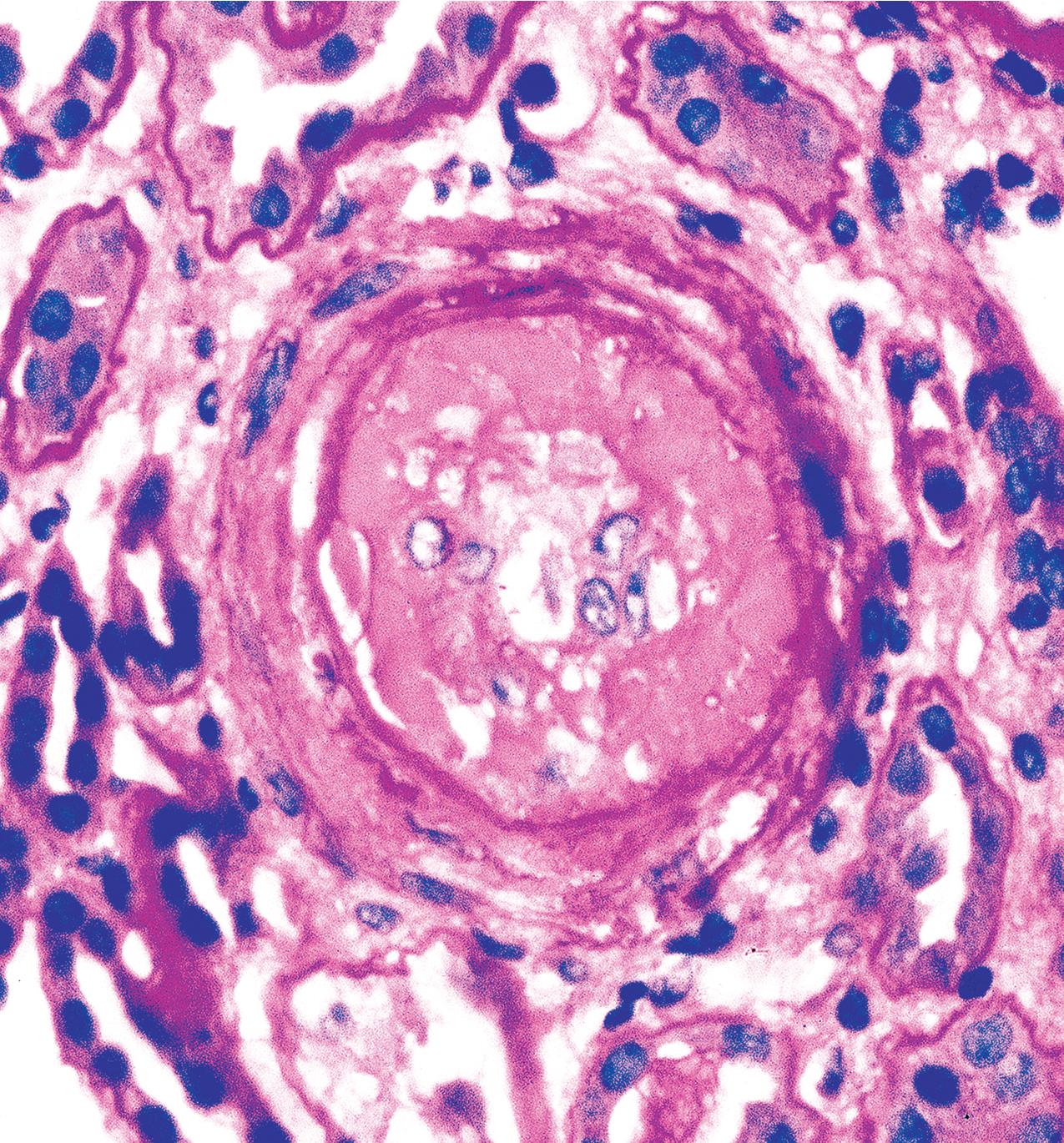
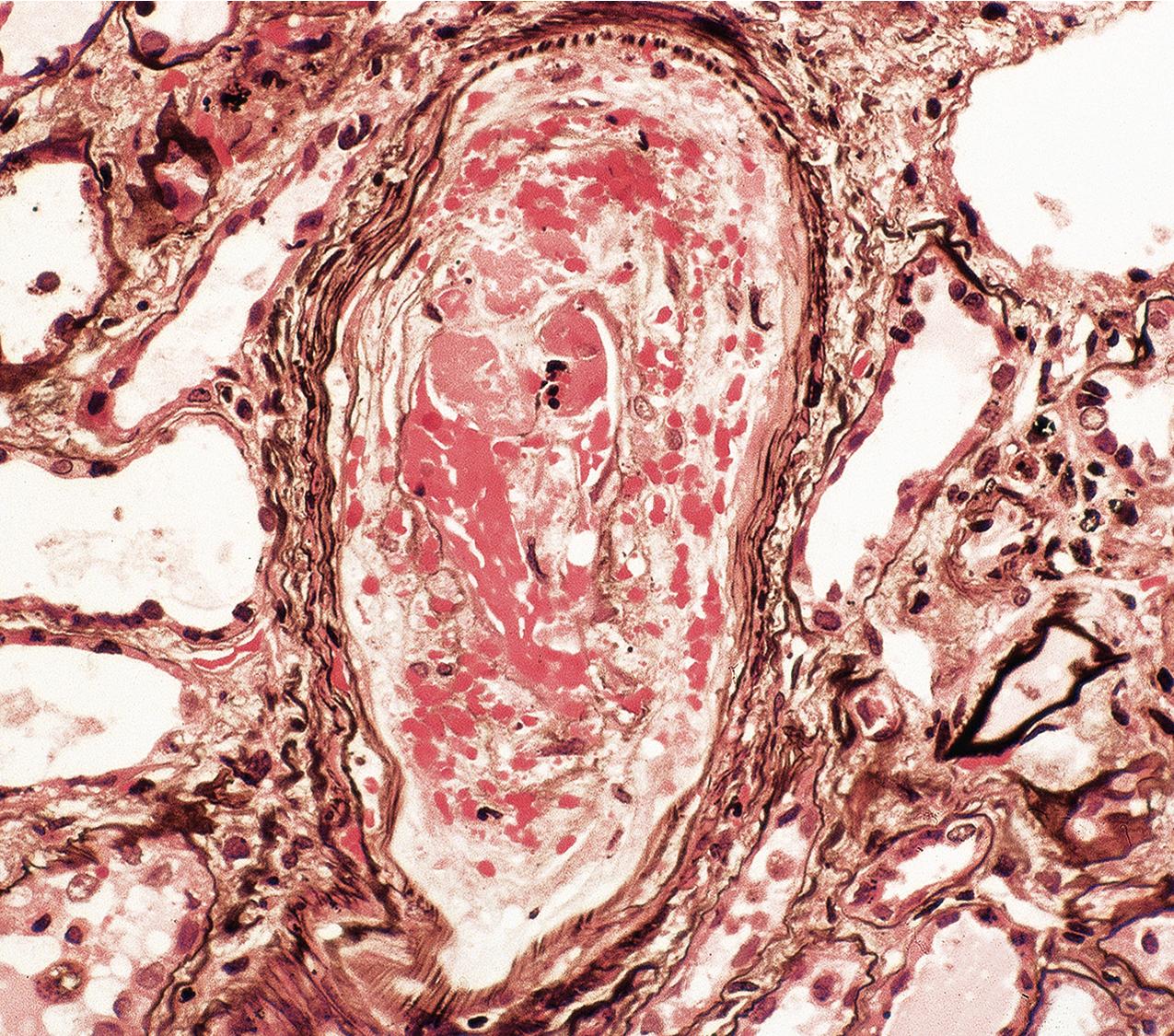
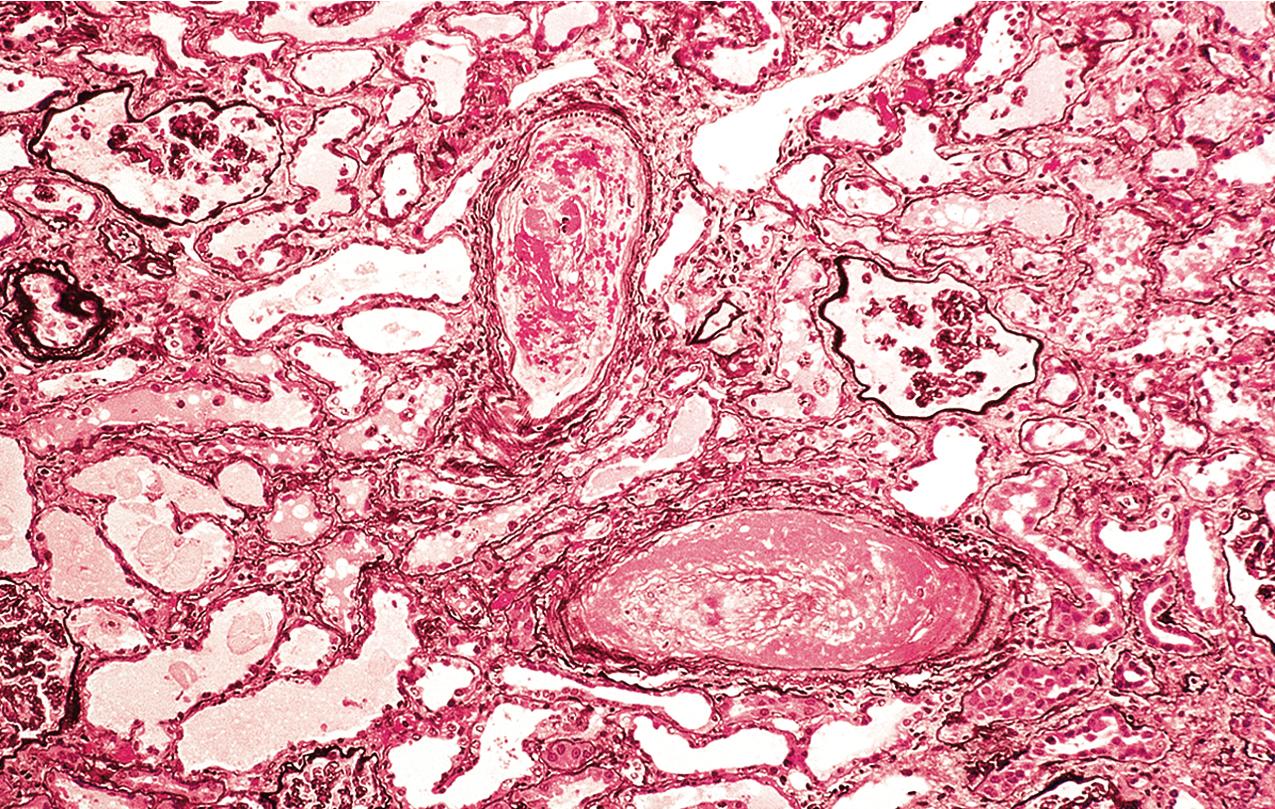
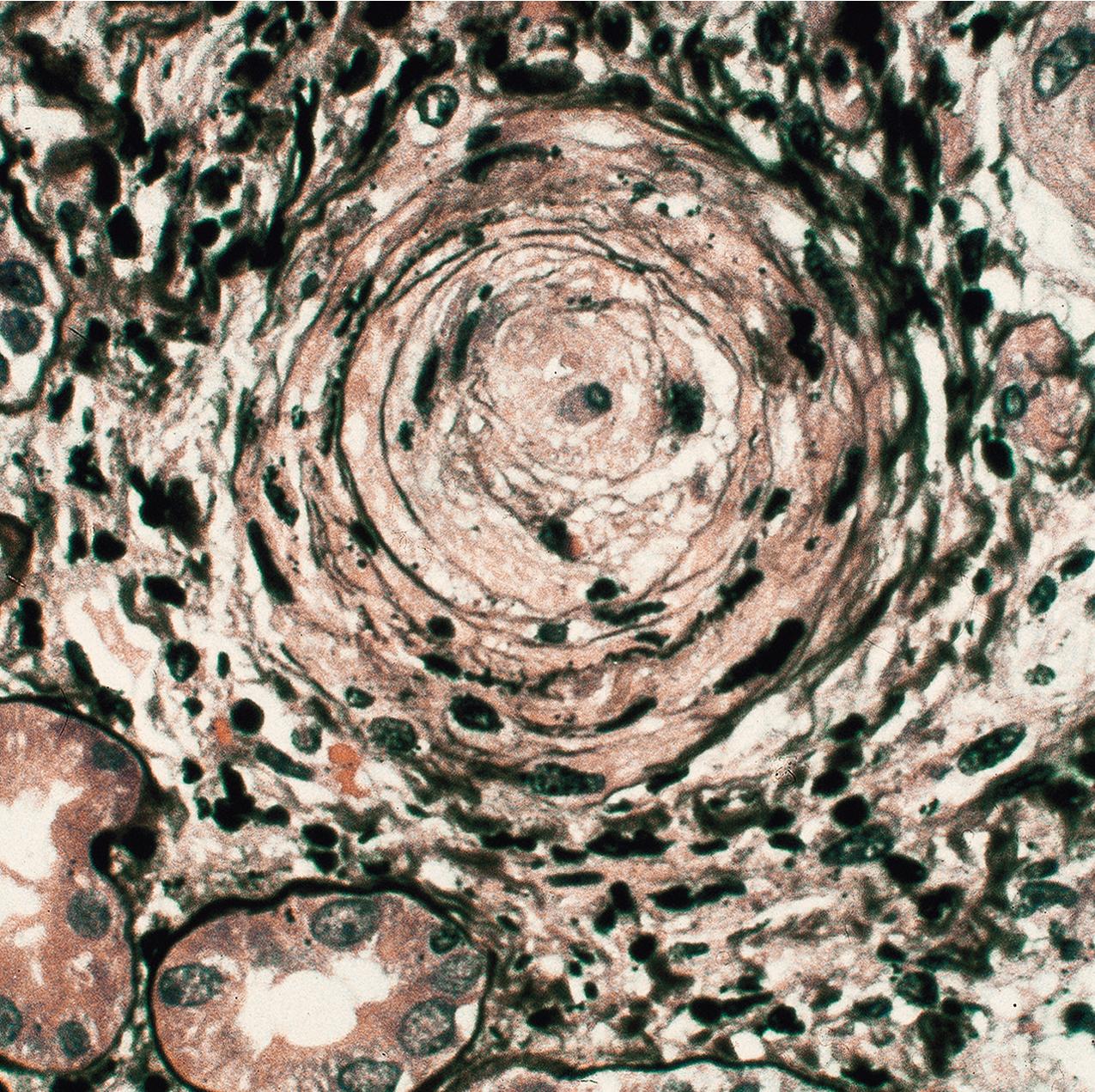
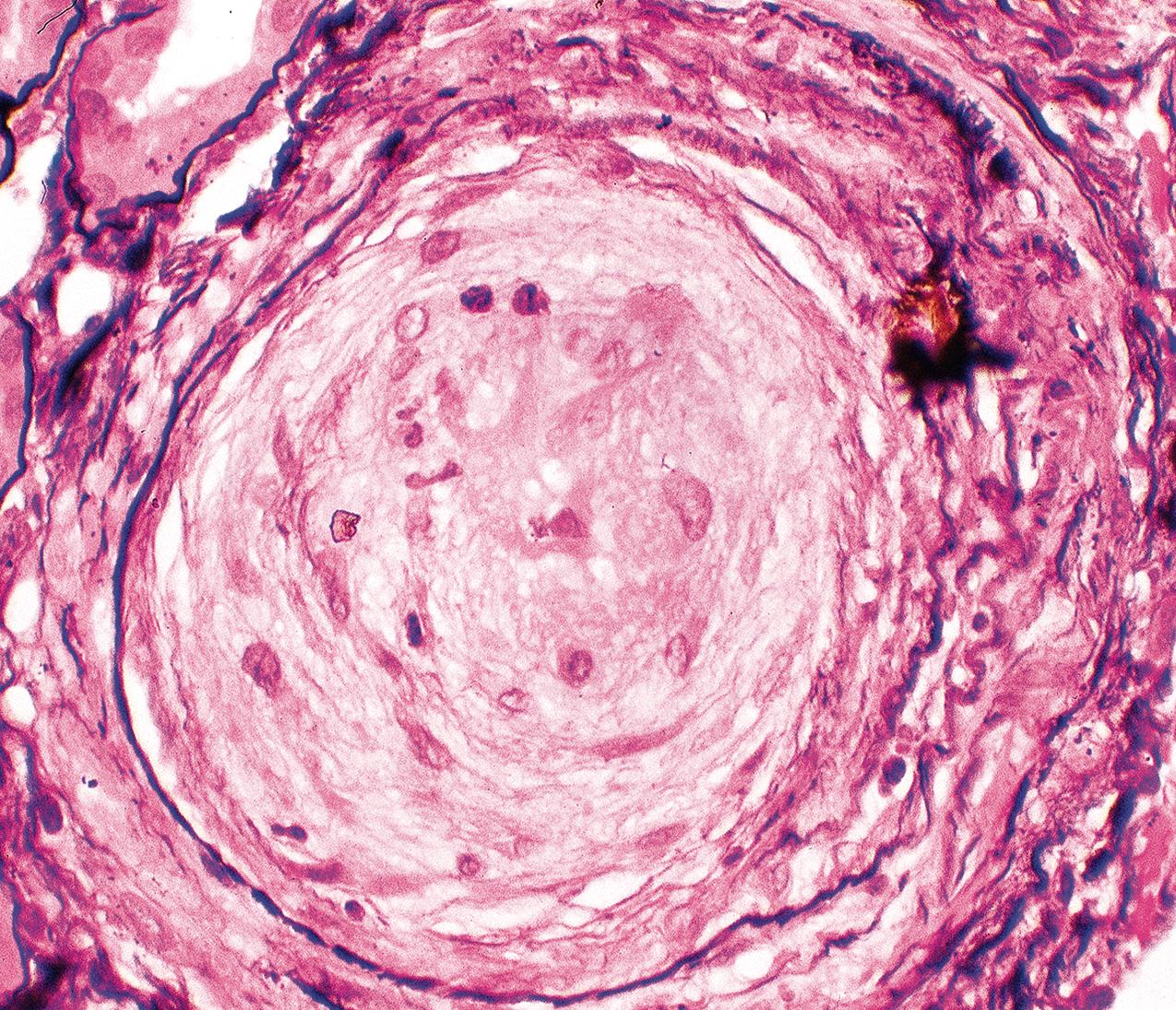

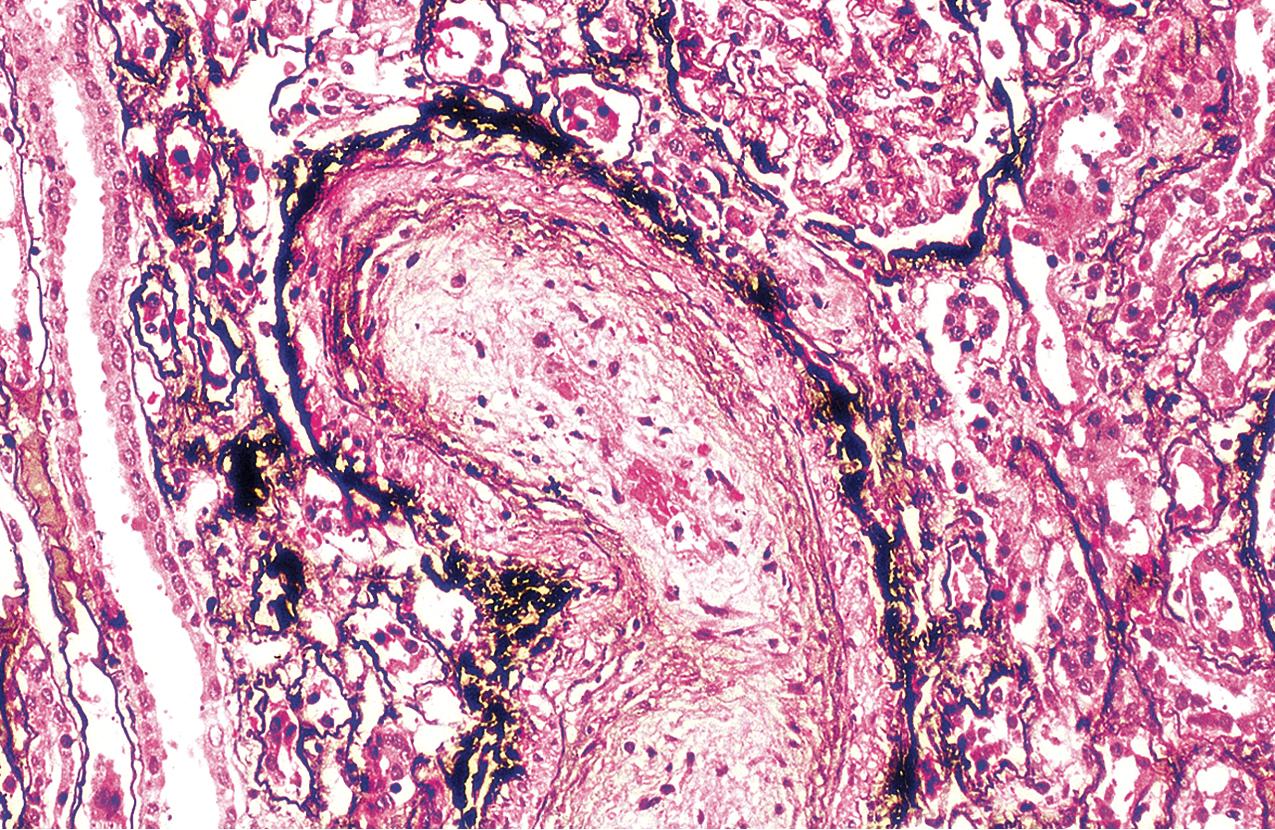
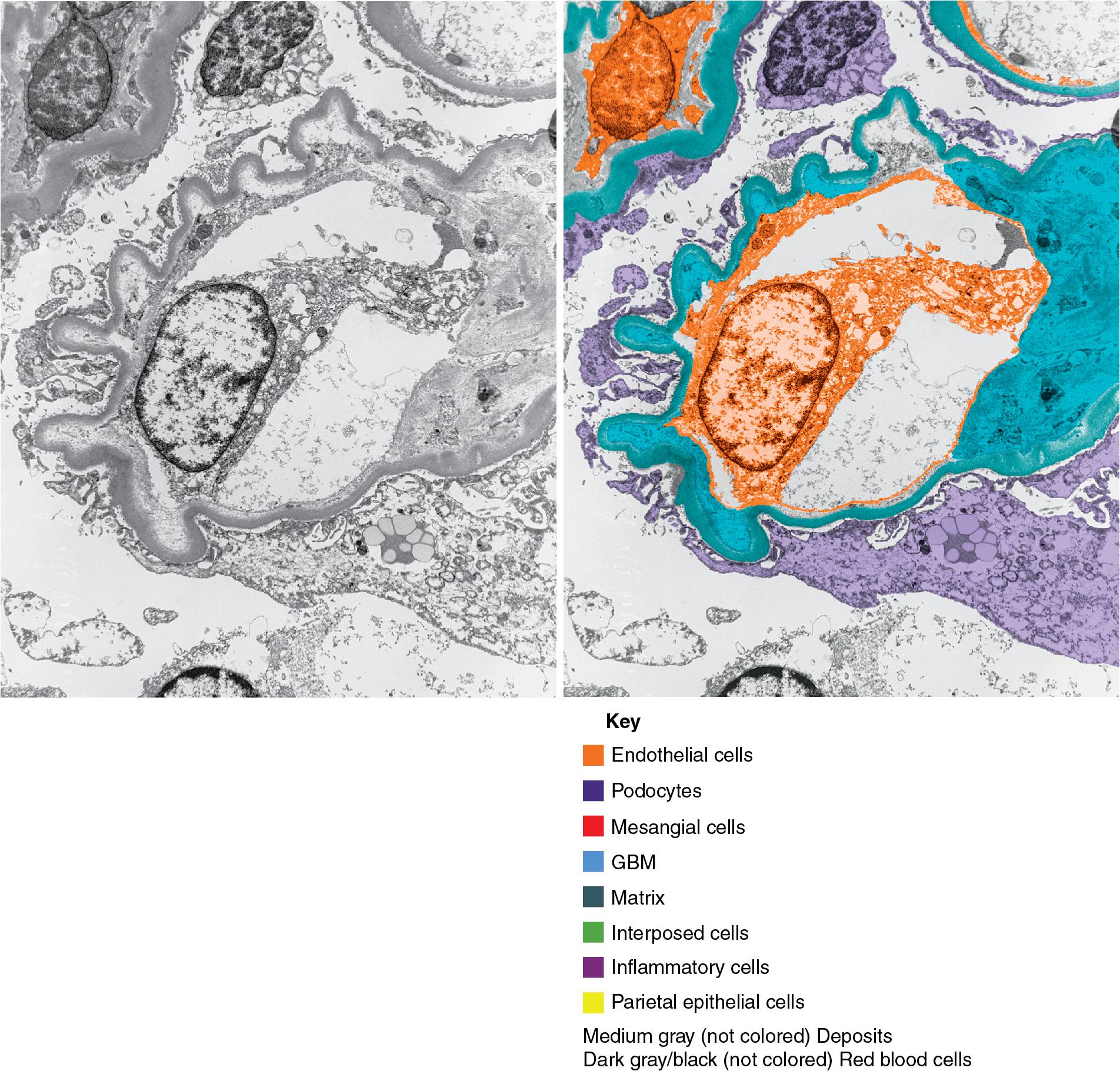
The pathologic appearance of SS overlaps with severe hypertension and TMA. Idiopathic severe hypertension tends to involve smaller vessels (i.e., afferent arterioles), whereas scleroderma renal crisis lesions may extend to interlobular size and larger vessels, and TMA, because of HUS, typically involves primarily glomeruli. Nevertheless, distinction of scleroderma and severe hypertension solely on morphologic grounds is not feasible, and clinicopathologic correlation is required for specific diagnosis.
The pathogenesis is unknown but likely involves immune mechanisms and endothelial injury with unknown inciting events, associated with excess collagen accumulation. Endothelial injury is thought to play a key role in renal SS and occurs early in the course of the disease, but whether it is primary or initiated by immune injury has not been elucidated. Arterioles develop large gaps between endothelial cells, and the endothelium is damaged with vacuolization. Perivascular infiltrates of mononuclear immune cells, obliterative microvascular lesions, and rarefaction of capillaries develop. Scleroderma patients also have a defect in vasculogenesis and deficiency of circulating endothelial progenitor cells.
Autoantibodies are often present, including anti-topoisomerase I, anticentromere, anti-RNA polymerase (RNAP III), each present in 25% of patients with scleroderma. Some studies have demonstrated cytotoxic antiendothelial factors in serum from scleroderma patients. Imbalance of vasodilators (e.g., nitric oxide, vasodilatory neuropeptides such as calcitonin gene-related peptide, substance P) and vasoconstrictors (e.g., endothelin-1, serotonin, thromboxane A2) has been described in SS patients. Prolonged vasoconstriction could contribute to structural changes and fibrosis in the kidney. Increased profibrotic factors, including transforming growth factor beta and connective tissue growth factor, have been described.
Fibrinoid necrosis of arterioles and interlobular arteries in acute stage
Mucoid change of arterioles/interlobular arteries with red blood cell fragments in subacute stage
Onion-skinning intimal proliferation of arterioles/interlobular arteries in chronic stage
Scleroderma versus malignant hypertension:
Severe hypertension–associated injury typically also has underlying changes of arterionephrosclerosis and may involve smaller vessels.
Clinical correlation is essential.
Bose N, Chiesa-Vottero A, Chatterjee S. Scleroderma renal crisis. Semin Arthritis Rheum. 2015;44:687-694.
Gabrielli A, Avvedimento EV, Krieg T. Scleroderma. N Engl J Med. 2009;360:1989-2003.
Mouthon L, Bussone G, Berezné A, et al. Scleroderma renal crisis. J Rheumatol. 2014;41:1040-1048.
Shanmugam VK, Steen VD. Renal disease in scleroderma: an update on evaluation, risk stratification, pathogenesis and management. Curr Opin Rheumatol. 2012;24:669–676.
Become a Clinical Tree membership for Full access and enjoy Unlimited articles
If you are a member. Log in here